2030-2039 Contents
2030
Global population is reaching crisis point
Explosive population growth - along with continued industrialisation of emerging economies - is having a catastrophic impact on food, water and energy supplies.*
In the early 2000s, there were six billion people on Earth. By 2030, there are an additional two billion, most of them from poor countries. Humanity's ecological footprint is such that it now requires the equivalent of two whole Earths to sustain itself. Farmland, fresh water and natural resources are becoming scarcer by the day.
The extra one-third of human beings on the planet means that energy requirements have soared, at a time when fossil fuel supplies are declining. A whole series of conflicts is now unfolding in the Middle East, Asia and Africa, at times threatening to spill over into Europe. With America involved too, the world is teetering on the brink of a major global war.
There is the added issue of climate change, with CO2 levels now reaching 450 parts per million. There are signs that a tipping point has been reached, which is manifesting itself in the form of runaway environmental degradation. Nature's ecosystems are beginning to collapse on a scale rarely witnessed in Earth's history.
The accelerating magnitude of these problems is leading to a rapid migration from traditional fossil fuels to renewable energy. Advances in nanotechnology have resulted in vastly improved solar power. This is enabling photovoltaic materials to be added to almost every new building. Maglev wind power is beginning to replace traditional wind turbines, allowing for much greater capacity in a smaller footprint. Energy supplies in general are becoming more localised and self-sufficient, while standards of power conservation have risen across the board. Clean coal is a further option now available. Meanwhile, 4th generation nuclear is close to being perfected and fusion power is only a decade or two away.
Although humanity is weening itself off fossil fuels, they remain the principal energy source in 2030 - accounting for nearly half of all power production.
Another issue which governments have to contend with during this time is the ageing population, which has seen a doubling of retired persons since the year 2000. People are living longer, healthier lives. Huge budget increases have been made for state pensions, but the funding is spread over such a large number of people that the overall effect is a decreased income for the average senior citizen. Retirement ages are increasing: in America, Asia and most European countries, many employees are forced to work into their 70s.
AI is widespread
Technology is accelerating exponentially. By 2030, the pace of change is so great that it will seem as if an entire century of progress has already occurred in the first three decades of the 21st century.* Scientific breakthroughs appear to be happening with startling frequency now - especially in the fields of computing, nanotechnology, medicine and neuroscience.*
Workplaces are becoming highly automated, with tremendous improvements in speed, productivity and efficiency. Ever-increasing use of portable, wireless devices has led to the evolution of near-paperless offices. Meanwhile, the need for hyperfast exchange of information has created enormous demand for video conferencing. This trend is reinforced by significant reductions in air travel, due to both spiralling fuel costs and environmental considerations.
Many companies are downsizing their administrative departments and replacing them with AI. This is particularly true of call centres, and other service-based roles, where customers often deal face-to-face with "virtual employees" based on automated software. Crude versions of these had been utilised as far back as the 1990s - activated by simple voice commands - but now they are presented onscreen as fully conversant entities.
Though lacking much in the way of personality, these sentient programs talk with "perfect" voices and are very pleasant on the ears.* They have a multitude of menu options and can usually deal with almost any query - however specific or unusual - thanks to their advanced voice and facial recognition software.
As competition increases, these virtual employees become a powerful marketing tool in the bid to provide the best possible customer service. In addition to mainstream companies, the adult entertainment industry gains a huge advantage from them, with enormous demand for their services. Research and development into artificial intelligence (and related hardware/software) increases greatly during this period. An added benefit of interacting with these virtual people is the elimination of caller queuing, since there is no need for physical staff anymore.
With AI playing a stronger role in society, concerns begin to arise of a "technological singularity" - as forecast by Ray Kurzweil and others. These fears prove to be exaggerated for now, in a manner similar to the Millenium Bug.
The USA is declining as a world power
A ballooning budget deficit, record levels of personal debt, and a declining manufacturing base, combined with excessive military spending and related activities (such as increased homeland security and surveillance) greatly damaged the US economy over the previous few decades. This caused long term damage to the country's standing.
The continued industrialisation of China and India has led to phenomenal growth in these and other Asian countries, with many millions being lifted out of poverty. Shanghai has eclipsed Wall Street as the leading financial centre.
Despite these changes, the US still retains its super power status - but every leading economist now acknowledges that it won't be the only country holding such influence for much longer. China, India and the EU are becoming major players on the world stage. What this means for geopolitical stability is the subject of much debate around this time, but many agree that a group of superpowers rather than a single hyperpower will mean increased conflict.
AIDS, cancer and a plethora of other diseases are becoming curable
The combination of stem cell research, synthetic genomics, nanotechnology and other breakthroughs has led to cures for a wide range of illnesses by now - including AIDS/HIV, the majority of cancers, motor neurone disease, arthritis and diabetes. Although Parkinson's and Alzheimer's have yet to be fully understood, dramatic progress is now being made thanks to reverse-engineering of the human brain.*
The growth of information technology in medicine has played an enormous role here. Ongoing, exponential gains in the scale, capacity and price performance of computer hardware (doubling annually) have transformed the ability to scan, analyse and decode the human body.
The tools to reprogram the information processes underlying biology are gaining a further boost from the growth of strong AI. This is being used to greatly accelerate research efforts. Automated software programs now combine the subtlety of humans with the speed, memory and knowledge sharing of non-biological intelligence.*
India becomes the most populous country in the world
Around this time, India overtakes China to become the most populous country in the world. By the middle of this decade it will be home to over 1.5 billion people. The gap between these two countries will continue to widen, with China's population actually declining from this point onwards.
As part of a climate change deal, foreign investment within India has enabled the country to build more than a hundred gigawatts of solar power facilities: enough to supply 200 million people with clean energy.* Together with its growth as a major IT centre, this has further improved its social and economic standing. At the same time, however, the effects of climate change are beginning to take hold. Droughts are posing serious challenges to food and water production.
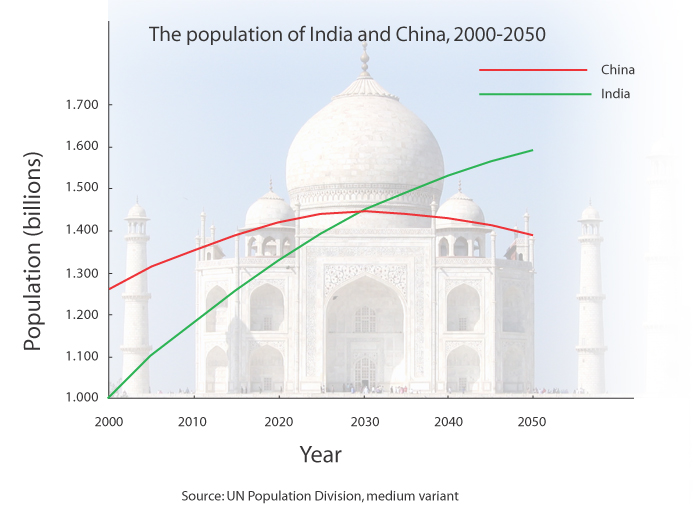
Full weather modeling is perfected
Zettaflop-scale computers are now available for scientific establishments. These systems are a thousand times more powerful than those of 2020 and a million times more powerful than those of 2010.
One field seeing particular benefit during this time is meteorology. Weather forecasts can be generated with 99% accuracy over a two week period.* Satellites can map wind and rain patterns in real time at extraordinary resolution - from square kilometres in previous decades, down to less than 10 square metres now.
Long-term global warming and climate modeling can also be achieved in far greater detail than ever before.
Emerging job titles of today
Some of the new job titles becoming widespread in 2030 include the following.*
- Alternative Vehicle Developer
- Avatar Manager / Devotee
- Body Part Maker
- Climate Change Reversal Specialist
- Memory Augmentation Surgeon
- Nano Medic
- Narrowcaster
- 'New Science' Ethicist
- Old Age Wellness Manager / Consultant Specialist
- Quarantine Enforcer
- Social 'Networking' Officer
- Space Pilot / Orbital Tour Guide
- Vertical Farmer
- Virtual Clutter Organizer
- Virtual Lawyer
- Virtual Teacher
- Waste Data Handler
2031
Web 4.0 is transforming the Internet landscape
Further convergence of the online and physical world has led to the emergence of "Web 4.0" - the next generation of internet. Semantic analyzing programs, having evolved into forms of AI, now perform a huge range of automated tasks for business, government and consumers. Running on massively parallel networks, these applications hunt for textual and visual data - combining the most subtle capabilities of humans (such as pattern recognition) with ways in which machines are already vastly superior (such as speed and memory).*
In addition to serving as highly advanced search engines, they are playing a major function in the real world - gathering information from the array of sensors, cameras and other tracking devices now present in the environment, on vehicles, and even on people themselves.
Although privacy and civil liberties issues are being raised, this new generation of IT promises to bring enormous benefits to society. Crimes are faster and easier to solve thanks to these intelligent virtual agents; transport and logistics are smoother and more efficient; resources can be managed and distributed more accurately.
In addition, practically every physical document in existence has now been digitally encoded, backed up and archived online. This includes full copies of all books, journals, manuscripts and other literature ever published – forming a complete repository of human knowledge going back thousands of years. These documents can be retrieved and analysed using real-time speech commands, translated from any of the world's 6,000 languages and accessed via 3D holographic imaging.
Web 4.0 is also democratising the Internet more than ever before. News agencies are finding themselves increasingly outmoded by bloggers and other social media when it comes to speed and accuracy of information.
Stem cell pharmacies are commonplace
Stem cell pharmacies are now a common sight on high streets. They offer walk-in diagnosis, stem-cell collection and banking services for use in future medical crises. Cheap, personalised and targeted treatments are available for the rapid regeneration of body parts and organs.*
Married couples are a minority
By now, marriage in the West has been reduced to the status of a lifestyle choice enjoyed by a minority, rather than an essential institution of society. This trend, which began in the 1980s, has seen the married population shrink from almost 50% of adults in 2009, to just 41% now.*
Increasing pressures of work and money, together with the general stresses of the outside world (including the ongoing energy crisis), are putting an ever-greater strain on couples. The decline of religious institutions has also played a part here. Unmarried partnerships no longer carry the stigma they once had.
In addition, increasing numbers of people either working at home alone, or living with their parents, are making it difficult for some to meet potential partners.
Another contributory factor is an explosion in the use of virtual reality - and other such technologies - which has led to increased individual isolation. People of all ages spend increasingly large amounts of their time engaged in highly immersive online experiences, requiring little or no interaction with the outside world.
Of those who are married, the number of children per couple has declined considerably in Western societies. Combined with increasing numbers of Muslim immigrants (who have much higher numbers of children), this is beginning to radically alter the demographics in some countries.
2032
Manned mission to Mars
Perhaps the most long-overdue space mission in history is finally undertaken during this time. A full six decades after the Apollo landings, technology is now vastly improved - particularly with regards to IT and telecommunications.
The costs involved are still enormous, however. Rather than going it alone, NASA is forced to share the burden with other nations.
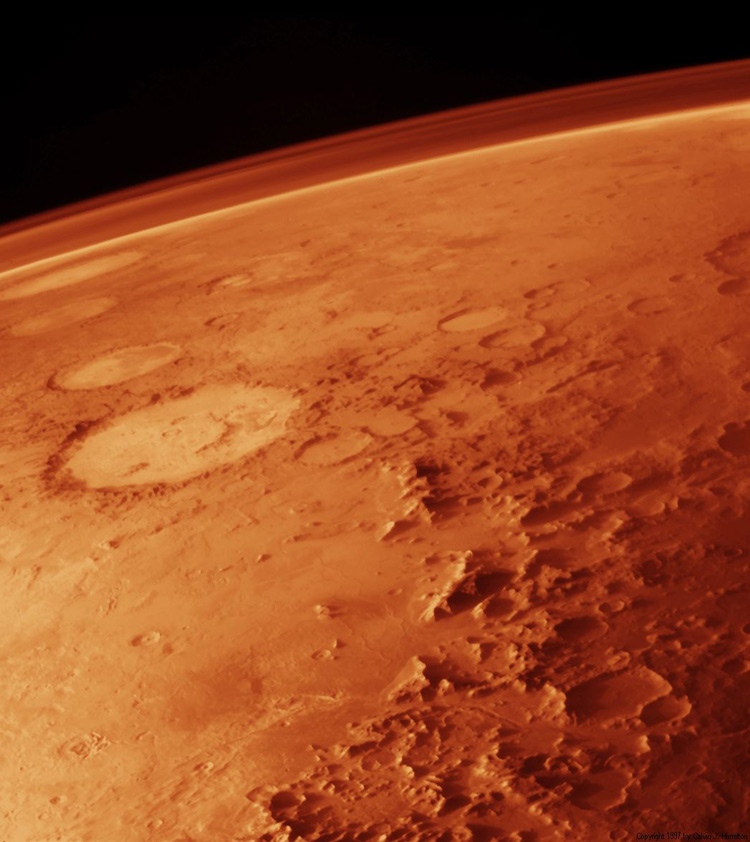
4th generation nuclear power
By this date, 4th generation nuclear power plants are commercially available.* They utilise a system of tiny ball bearings, rather than large fuel rods. They are a major improvement over previous generations, for the following reasons:
By this date, 4th generation nuclear power plants are commercially available.* They utilise a system of tiny ball bearings, rather than large fuel rods. They are a major improvement over previous generations, for the following reasons:
- It is physically impossible for them to have a runaway chain reaction, as happened with Chernobyl. No error, human or otherwise, will ever produce a meltdown.
- The uranium fuel is only 9% enriched. This makes it impossible to be used in terrorist nuclear weapons.
- The nuclear waste is much easier to dispose of.
- They are highly economical. Electricity can be generated more cheaply than oil or gas power, even when the decommissioning costs of the stations are taken into account.
For these reasons, nuclear power becomes a lucrative industry from the 2030s onwards. China and India, in particular, take advantage of this enhanced power source.
Solar and wind power has greater long term potential, however, due to the finite supply of uranium.
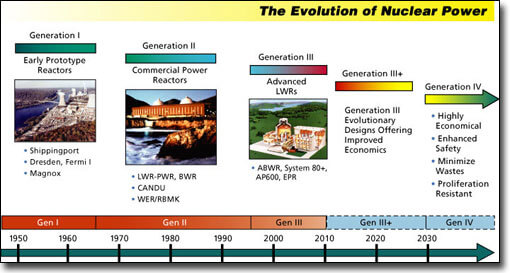
Terabit internet speeds are commonplace
In addition to the benefits resulting from Web 4.0 (described earlier), connection speeds have also vastly improved. Bandwidth has been growing by roughly 50% each year. Many households in the developed world now have a terabit connection.*
A significant number of these connections are now appearing on people themselves, in the form of wearable or implantable devices.
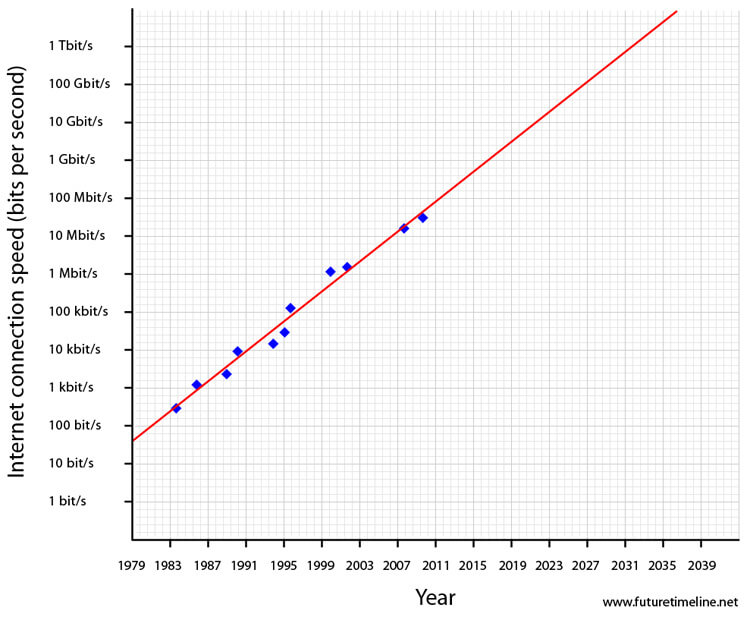
2033
Hypersonic airliners are entering service
Following decades of research and development, a new generation of aeroplanes are entering commercial service.*
These aircraft have a cruising speed of Mach 5 - or about 3,800 mph - enabling them to fly from Europe to Australia in less than four hours. With a range of more than 20,000km (12,000 miles) they can perform this journey without refuelling and have excellent subsonic and supersonic fuel efficiency, thus avoiding the problems inherent in earlier supersonic aircraft. Furthermore, and perhaps more importantly, they are environmentally friendly. Being powered by liquid hydrogen, their only waste products are water vapor and small amounts of nitrous oxide.
Another advantage is that, while the 150 metre-long designs are much bigger than previous jets, they are actually lighter than Boeing 747s and can utilise conventional airport runways. They have moderate take-off noise, too.
In many ways, they are the spiritual successor of Concorde.
However, they do not have windows. The heat generated by traveling so fast makes it difficult to install windows that are not too heavy. One solution to this problem has been the installation of flat screen displays, showing images of the scene outside.*
Holographic wall screens
Conference halls, office headquarters, modern art galleries and other such environments now have access to holographic wall screens. These are substantially larger versions of the TV projectors which have been in use since the 2020s. These upscale models are becoming so large that they can fill entire rooms. At this stage, they remain far too expensive for mainstream use in the home (except for luxury apartments owned by the rich and famous). However, they are a relatively common sight in workplaces, where video conferencing is playing an increasing role in business; and in entertainment venues such as movie theatres, nightclubs and stadiums.
Times Square in New York, Piccadilly Circus in London, and Shibuya in Tokyo now feature spectacular advertisement displays, with graphics appearing to literally "jump out" of the screen.
IT's share of the US economy reaches 15%
The trend in IT growth is shown below. This has been consistent since at least the 1970s and there are no signs of it slowing down. Major industries fueling this growth now include biotechnology, nanotechnology, leisure and entertainment (especially VR) and the development of AI.
By the end of the century, over a quarter of America's GDP may be based on IT, as the demand for physical goods and services decreases, being replaced with virtual and digital goods and services online.
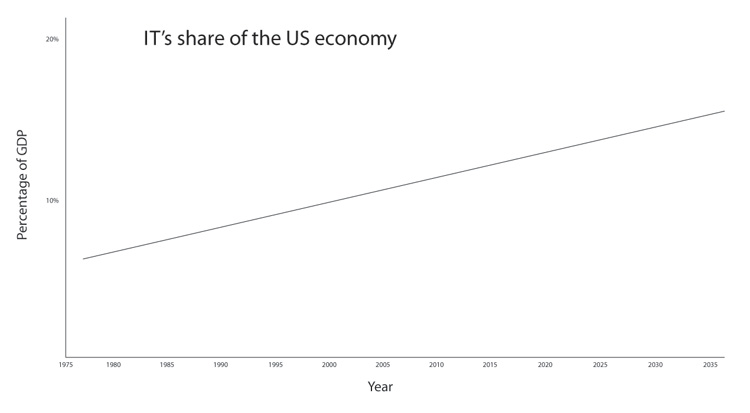
Lung disease in China has killed over 80 million by now
This has resulted from the combined long term effects of (a) pollution; 20 of the 30 most polluted cities in the world are in China, (b) huge numbers of smokers; around 50% of adults, and (c) the widespread practice of burning wood or coal at home for cooking and heating; over 65% of the population.*
China has begun switching to cleaner fuels by this time, however - and is implementing a new programme of taxation, better health education and tobacco advertising bans. This begins to reduce the proportion of deaths from lung disease from around this time onwards.
2034
Exabyte storage devices are available
Data storage devices are now available with capacities of more than one exabyte (a million terabytes). This might seem excessive to observers from earlier decades. It has become necessary in today's world, however, due to the exponential growth of information technology. The day-to-day experiences of the average person now involve a stupendous amount of data collection - especially for those using neural interfaces or biotechnology implants.
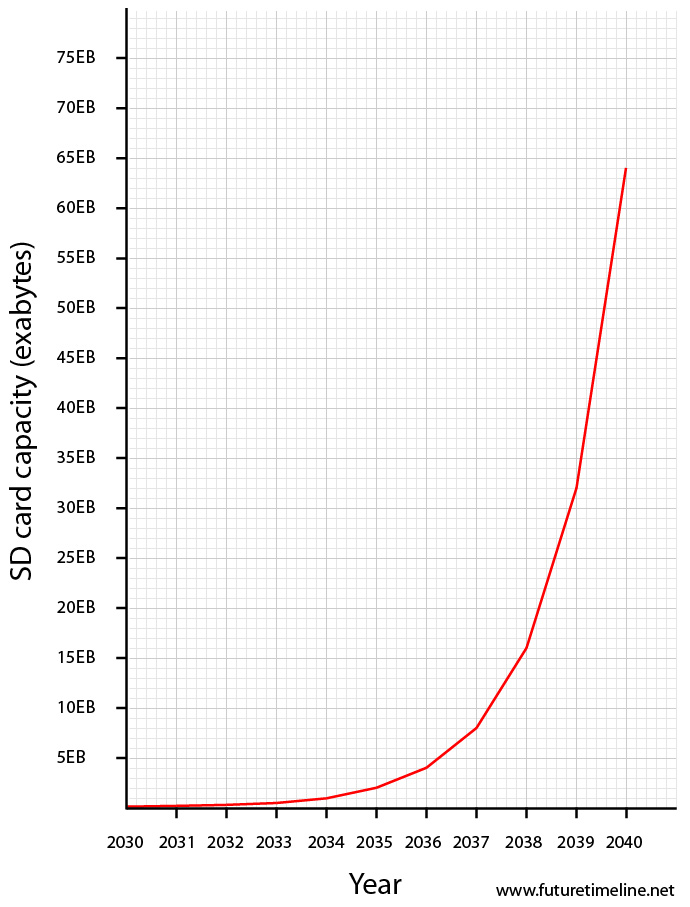
2035
Turmoil in the Middle East
The main driver of the Middle East economy - oil - has been declining for the past two decades and is now undergoing spectacular falls in production as the world adjusts to the reality of peak oil.*
Following years of disruption and a race to avert catastrophe, viable alternatives for humanity's energy needs have become a realistic prospect. Algae biofuel is leading the way.** Solar, wind and other forms of renewable energy have also borne fruit. With nanotechnology being applied to panels, together with plummeting costs, solar energy has seen exponential uptake.* Energy storage systems have made progress alongside this, allowing solar to be used even at night time.* Electric cars are becoming widespread too, accounting for more than half of new vehicles on American roads.*
No longer funded by the West's limitless demand for oil, the Middle East is collapsing into a largely poverty-ridden, internally feuding region. A "brain drain" ensues, as it falls back into relative insignificance.
Much of Israel still lies in ruins, following a series of devastating conflicts - including the use of nuclear weapons. Several neighbouring countries have been engaged in an arms race that has further destabilised the region.
The Arctic is becoming ice-free during summer
Due to global warming, the Arctic is now completely free of ice during summer months. A dramatic decline in sea ice coverage was observed during 2007. This trend continued over the subsequent decades, the process accelerated by the increasing surface area of water - being darker, the sea absorbed more of the Sun's heat compared to reflective white ice.
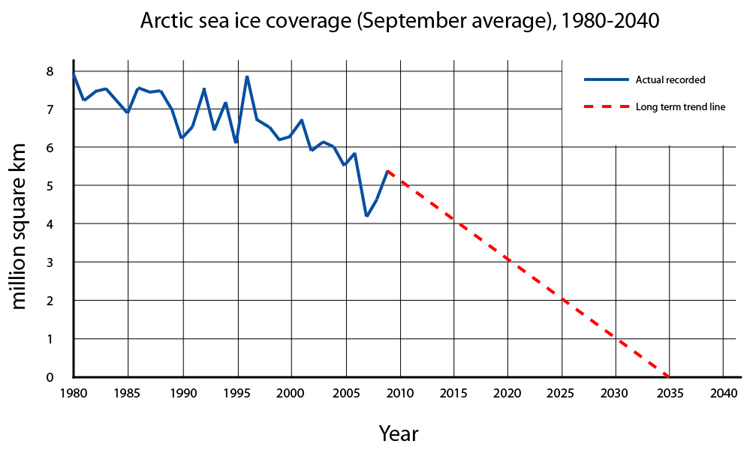
Source: NASA
Self-driving vehicles are widespread
In many developed countries - especially within the EU - a new generation of self-driving vehicles is emerging. These use a combination of advanced GPS, AI and lane-changing technology to carry passengers to their destination automatically. As well as improving road safety, many of these cars are electric, or hybrid electric, reducing their impact on the environment.
Holographic recreations of dead people
Throughout this time many dead celebrities, presidents and historical figures from the past are "resurrected" online, via the immense AI and supercomputing powers now available. This phenomenon is aided by the recent human brain simulations that have been made possible. Data mining of every single word ever spoken, written, or otherwise recorded by the person is undertaken, then analysed to recreate their character traits and emotions. This allows the construction of a highly accurate "shell" personality, surrounding a generic "core" program, run as an entirely independent AI simulation.
The project sparks much controversy when first announced (especially among the religious community) but soon gains momentum, as a whole host of actors, musicians, artists, scientists, politicians and other individuals from the past are made available.* Advanced holographic techniques - combined with real-time audio-visual interaction - make them appear as lifelike as any other person alive in the world today.
This form of computerised resurrection is soon extended and made possible for ordinary citizens wishing to preserve a loved one in digital form; though once again, it is more popular among the non-religious (and the process is generally less accurate, since the average person tends to leave behind less data, written words, video recordings and other information for use in constructing the programs). The technology involved is also expensive. It is used only by the rich for now - or in certain public locations such as museums, galleries and other venues.

Robots are dominating the battlefield*
A variety of mobile, autonomous fighting machines are appearing on the battlefield now. Guided by advanced AI, they can aim with inhuman precision and come equipped with powerful sensors, GPS and thermal vision. They can be deployed for weeks or months at a time if necessary, without need for rest or maintenance. They have other advantages too - such as a complete lack of remorse or fear; no need for training, or retirement payments, or other such costs. These machines are being used in a wide variety of conflicts (especially food/energy/resource-related) where they spread terror and confusion through the ranks of their enemies.
In fact, only the poorest or most desperate enemies are fielding human troops against this new and deadly force. This is giving the US an advantage in battlefield situations, allowing the country to regain some of the power and influence it has lost in previous decades - at least with regards to armed conflicts.
The most advanced robot models come with self-repairing nanobot systems and immunity to EMP attacks. Some can even turn themselves invisible through the use of metamaterials.
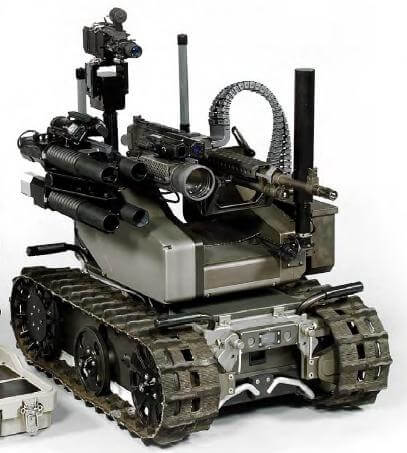
Credit: Qinetiq
Artificially-grown meat is available to consumers
Advances in tissue engineering have made it possible to actually "grow" meat - using just single animal cells.*Having been in development for over 30 years, it has now reached the stage where it can be safely mass-produced and made available for the public.*
The meat itself has a number of benefits. It is unusually pure, clean and healthy whilst retaining the original flavour, texture and appearance of traditional meat. It can also be produced without harm or cruelty to animals, being just a lump of cultivated cells. Perhaps most importantly, it has far less impact on the environment.
It is also much cheaper than ordinary meat, which is especially beneficial to developing countries, many of which have seen their agricultural systems ravaged by climate change.
Like GM crops and other such radical advances, a number of political and psychological hurdles stood in the way of its development. This meant its introduction to the mainstream was delayed by several years. However, the aforementioned crisis in farming - along with endorsements from animal welfare groups - gave added impetus and eventually pushed it through.
Bionic eyes surpassing human vision
Although yet to become mainstream, a bionic eye is now available that not only restores sight, but actually exceeds normal human vision. This breakthrough has been made possible due to exponential advances in sensor technology and computer power.
The first generation of these implants began appearing in the late 2010s.* They were somewhat crude initially - providing only a very pixelated view of the world and requiring the use of glasses frames for mounting the cameras.
This latest generation, however, is such high resolution that it now exceeds the sensitivity of natural human eyes. Gigapixels of resolution can be captured and transmitted to the optic nerve into the visual centres of the brain. Externally mounted cameras are no longer necessary - these have been miniaturised by a factor of thousands and incorporated within the eye itself.
Bionic eyes will soon begin to offer more than just ordinary sight. They will be capable of providing infrared vision, for instance, for improved health and safety in night-time situations. They will include video recording capabilities, serving as the ultimate in portable webcams. The convergence of Web 4.0 and augmented reality will enable users to receive detailed information on their surroundings, just by looking around them.*
The cost of these implants is also dropping substantially, thanks to exponential improvements in price performance. Having been tens of thousands of dollars in earlier decades, they will soon be available for less than $100.
Detailed probing and mapping of the Kuiper Belt is underway
Advances in telescope power have revealed a plethora of new bodies in the Kuiper Belt - many rivalling Pluto in size. At the same time, a new generation of solar-sail technology is emerging. Spacecraft using this form of propulsion were first demonstrated in 2010. Much larger versions are now being deployed. Some have membranes extending hundreds of metres, with greatly improved thrust-to-mass ratio - up to 50 times higher than in previous designs. This is made possible through a combination of nanotechnology and space-based production of sail panels.*
Following in the footsteps of New Horizons, a whole series of these probes is being sent to the Kuiper Belt; a place that until now was largely unexplored. Close range studies are conducted on a number of the ancient, icy planetoids of this remote region.*
With improving telescopes and longer-range probes, mankind is penetrating ever further into the depths of space. Astronomers are forming a highly detailed, accurate picture of our Solar System as a whole.

Credit: NASA
2037
Quantum computers are becoming available
Certain government agencies, universities and research institutes now have access to this revolutionary form of technology, which offers spectacular computing speed and power on a completely different scale to anything used before. These machines work by making direct use of quantum mechanical phenomena, such as superposition and entanglement, to perform operations on data. In addition to being trillions of times faster than earlier computers, they can be made absolutely secure, too. The machines' encryption techniques are virtually unbreakable, due to the almost unimaginable number of instructions being executed simultaneously.
2038
Teleportation of complex organic molecules
In the early 2000s, scientists were able to transfer particles of light (with zero mass) over short distances.
Further experiments in quantum entanglement led to successful teleportation of the first complete atom. This was followed by the first molecules, consisting of multiple atoms.
By the late 2030s, the first complex organic molecules - such as DNA and proteins - are being teleported.*
The FIFA World Cup trophy is replaced
The current trophy has been in use since the 1974 World Cup. There is only space for 17 countries to be engraved on its base. In 2038, the final name plaque is filled in, and a replacement cup is commissioned with a new design. Like its predecessor, this is made of 5 kg (11 lb) of 18 carat (75%) gold.*

2039
Full immersion virtual reality
Towards the end of this decade, personal computers are becoming sophisticated enough to bring full immersion virtual reality to the mainstream.*
In other words, users now have the option of actually "being" in a video game and experiencing its graphics, audio and other effects (e.g. tactile feedback) in a manner that is practically indistinguishable from the real world.
This stunning breakthrough has been achieved through exponential trends in computing over the previous decades - including a billionfold improvement in processing power and price performance, combined with a 100,000-fold shrinkage of components and circuitry.*
For the first time, human brains are actually being merged with computer intelligence. Rather than viewing games on a screen, users now experience the game from within their own nervous systems, as though it were an extension of their mind. Players undergo a simple, minimally invasive procedure to insert nanobots (blood cell-sized devices) into their bodies. These microscopic machines are self-guided towards the neurons in their brain responsible for visual, auditory and other senses. Here, they remain in a dormant state, but in close proximity to the brain cells.
When the user wishes to experience a simulated reality, the nanobots immediately move into place, suppressing all of the inputs coming from the real senses, and replacing them with signals corresponding to the virtual environment. If the user decides to move their limbs and muscles as they normally would, the nanobots again intercept these neurochemical signals - suppressing the "real world" limbs from moving, and instead causing their "virtual" limbs to move within the game. This means a user can be sitting in a fixed position, while experiencing a high degree of activity and movement.
Although most people are initially wary of these devices, they have been around in some form since at least 2025 (eg. for medical purposes) and years of testing, security and safety measures have gone into this latest generation. Detailed regulations are now in place which cover any possible eventuality. For example, a power cut means the nanobots simply detach from the neurons - automatically returning a user to the real world - while checks are constantly performed to ensure there is no danger of being "trapped" in a virtual environment.
Furthermore, the machines are not permanent and can be removed from the body altogether if desired. In any case, it is practically impossible for them to damage nerve cells or cause any lasting damage, due to their small size and limited functionality. Over the next few years, many people come to accept them as a natural part of their bodies – just as bacteria and other small objects are part of their stomach, digestion and other internal processes.
Full immersion VR isn't just limited to games. With such huge creative scope, it is being used for a whole range of applications now: from business to education, training, healthcare, engineering, design, media and entertainment.
Tourism is being revolutionised, since people no longer have to travel great distances or spend large amounts of money to explore the sights and sounds of another location – they can simply go online. For this reason, a number of travel firms are going bust around this time, or else drastically changing their business models to account for this new medium.
Of course, that’s not to say these online holidays are intrinsically better than the real thing. Although on a different scale of technical wizardry compared to graphics of previous decades, they are still somewhat limited in their accuracy of towns and cities. At this stage, many of them lack sufficient AI, are often sparsely populated, and miss out vital details or subtle characteristics of foreign culture... things which make real-life travel such an enriching, worthwhile experience. Decades of refinement will be needed before VR is entirely convincing.
Nevertheless, this new phenomenon is so profound in its depth of interactivity – as well as sheer convenience, accessibility and ease of use – that it presents a serious threat to old-line travel agencies.
One way that the industry adapts to this is by offering more detailed, advanced and sophisticated holiday environments, for a fee. However, this becomes only a temporary solution, as certain users find a way to pirate these programs, which are then duplicated and shared online. The problem is exacerbated by groups collaborating to form their own free/open source programs, which combine the best elements from these and others, and are easy to customise by the casual user. In some cases, "hybrid" versions of holiday destinations are being created which offer wholly new, surreal and bizarrely dreamlike experiences. One such example might be a recreation of New York with a tropical coastline, populated by characters from Star Wars.
Just as the internet led to a decline in the music industry, the same is now happening to the travel industry. From the 2040s onwards there is a massive decline in air travel and overseas holiday bookings. The effects of climate change and worsening environmental crises are also playing a part here. A growing number of citizens are choosing to stay at home, with most communication and interaction being done online. The same is true of businesses – especially with regard to meetings and conferences, which are increasingly being held in virtual settings.
One area of commerce with no such troubles is the adult entertainment industry. Full immersion VR allows users to meet and interact with people in astonishingly lifelike ways. This includes virtual recreations of glamorous celebrities and film stars…

Universal translators are ubiquitous
On-person devices that instantly translate speech, text or handwriting from any of the world's 6,000 languages are widespread by this time.* This includes contact lenses with Internet connections, capable of displaying subtitles in the wearer's field of vision.* Every website and virtual environment now has translation facilities too.
This technology has the effect of speeding up many bureaucratic/administrative procedures in business and government – as well as improving trust and cooperation at both a national and individual level.
Nanotech fabrics are ubiquitous
Nanotech fabrics are everywhere now. They are available for a huge range of clothing, footwear and accessories, some of which are remarkable in their design. For instance, many clothes can be programmed to change their molecular structure to alter their colour, texture or style. Others have self-cleaning abilities, with micro-thin layers of disinfectant to regulate germs and dirt.
Others have more exotic properties. One such example is a material that can replicate the texture of geckos' feet. This allows people to stick to vertical surfaces, giving them Spiderman-like agility.* In addition to outdoor adventurers and climbers, a number of radical activists are making use of this. Eco-protesters for example are often seen on the news, scaling prominent buildings to unveil banners and placards. A number of government offices and corporate headquarters are being targetted in this way – raising fears of more serious incidents involving terrorists. Many companies are forced to improve their security measures.
More advanced "chameleon"-style fabric is being utilised by special forces. This comes in the form of fully-enclosing suits which change colour to match the wearer’s environment, providing a near-perfect means of camouflage.*
Australia's national symbol, the koala, faces extinction
By this date, the koala population in Australia has dwindled to almost nothing, due to the combined impacts of drought, disease, climate change and loss of natural habitat.*
US population reaches 400 million*
This compares with 309 million for the year 2010. Most of the population growth has occured in urban areas.
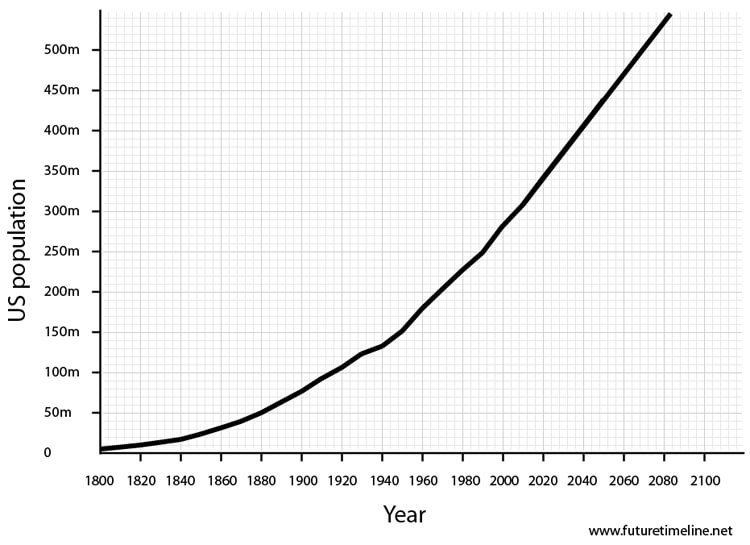
Extreme heatwaves are commonplace in the US
The previous five decades were all the hottest on record - each surpassing the last. Extreme heatwaves are now having a serious impact on agricultural yields and human health. This is a particular problem in the American West. From 2030 to 2039, most areas of Utah, Colorado, Arizona and New Mexico have at least seven summers equal to the hottest season ever recorded between 1951 and 1999. The hottest daily temperatures of the year from 1980 to 1999 have become twice as frequent. There are persistent, drier conditions around the country, with substantial reductions in soil moisture and an accompanying rise in forest fires.*
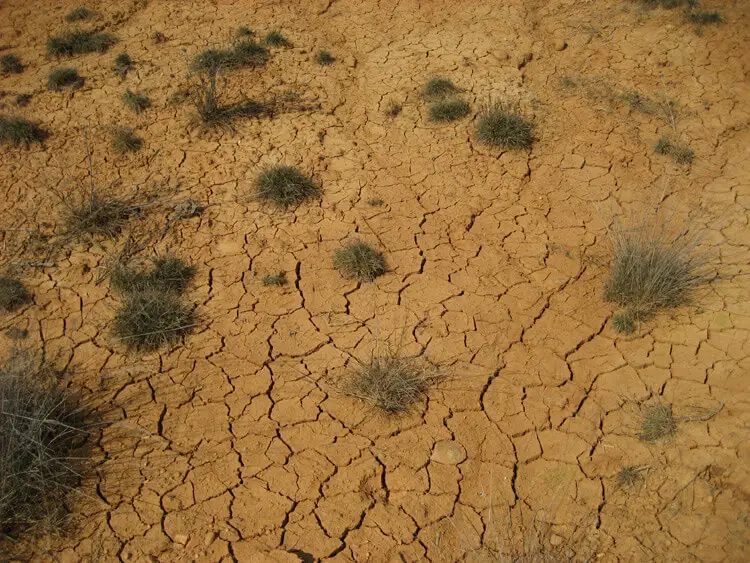
Credit: dl91m
2040-2049 Contents
2040
Clean energy is widespread
Widespread use of nanotech fuel cells, maglev wind power, hyper-efficient solar and 4th generation nuclear is gradually relegating fossil fuels to obsolescence. The latter are, in any case, dwindling in availability - and have been for some time. Fusion power is also close to being perfected now.
Widespread use of nanotech fuel cells, maglev wind power, hyper-efficient solar and 4th generation nuclear is gradually relegating fossil fuels to obsolescence. The latter are, in any case, dwindling in availability - and have been for some time. Fusion power is also close to being perfected now.
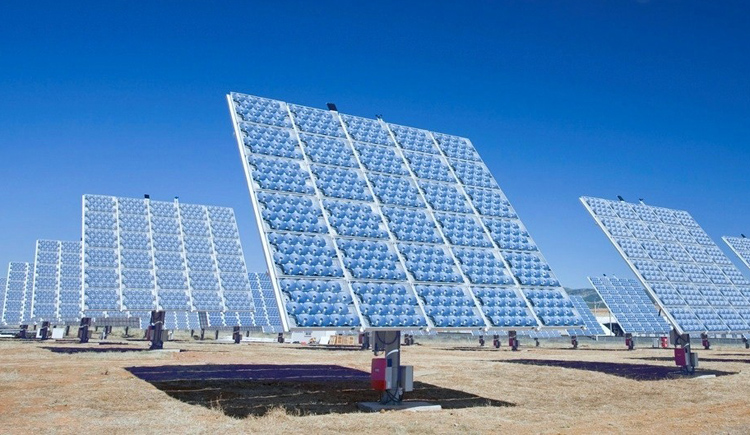
Fusion power is nearing commercial availability
A prototype commercial fusion reactor is entering its final phase of operation.* DEMO (DEMOnstration Power Plant) is the successor to ITER and has built on the success of that project, achieving a number of major breakthroughs. Among the earlier problems which have now been solved are: containing the plasma at high enough temperatures, maintaining a great enough density of reacting ions, and capturing high-energy neutrons from the reaction without melting the walls of the interior.
A prototype commercial fusion reactor is entering its final phase of operation.* DEMO (DEMOnstration Power Plant) is the successor to ITER and has built on the success of that project, achieving a number of major breakthroughs. Among the earlier problems which have now been solved are: containing the plasma at high enough temperatures, maintaining a great enough density of reacting ions, and capturing high-energy neutrons from the reaction without melting the walls of the interior.
Constructed from 2024 to 2033, DEMO is now close to being perfected - having undergone several years of testing, expansion and upgrades. Later this decade, it will be capable of producing a sustained output of 2 gigawatts (GW), making fusion commercially available for the first time.*
"Energy islands" are appearing in many coastal regions
Many countries are now suffering chronic water shortages due to the effects of climate change and overpopulation. This is a particular problem in developing regions. Higher global temperatures are causing lakes, wells and reservoirs to run dry, even as populations continue to rise.
One strategy being used to alleviate this crisis involves compact, floating "energy islands". These combine offshore power generation with desalination plants. First developed in the 2010s, they are becoming a fairly common sight in tropical coastal areas, where conditions are ideal for ocean thermal energy conversion (OTEC).
Each island is hexagonal in shape and interlocked with other islands, forming artificial archipelagos. Wind turbines and concentrated solar power are installed on the topsides - while on the undersides, flash-evaporated seawater is used to drive turbine generators, in turn producing drinkable water.*
A single 250-megawatt OTEC plant can meet the energy demands of 250,000 households and provide 600 million litres of drinkable water each day.* Any surplus water can be used to support local agriculture and industry.
These islands also feature housing developments, fish farms, greenhouses and eco-tourism complexes, in addition to the water and power production facilities.*
In the 22nd century, they will evolve into much larger versions - entire "micronations" capable of roaming the seas.*
Click to enlarge.
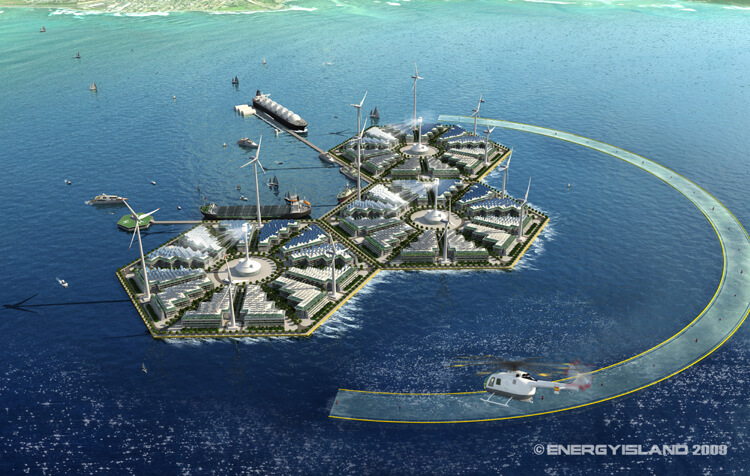
© Energy Islands. Image reproduced with permission.
Thought transfer is dominating personal communications worldwide
The first generation of brain-computer interfaces reached the consumer market in around 2010. This technology was crude and limited to begin with: more of a novelty than a serious application. Devices could perform only the simplest of operations, such as directional commands.**
The first generation of brain-computer interfaces reached the consumer market in around 2010. This technology was crude and limited to begin with: more of a novelty than a serious application. Devices could perform only the simplest of operations, such as directional commands.**
Some university experiments were successful in creating text messages, using thought power alone,* but were slow and required bulky equipment to do so.
Advances by 2020 enabled the sending of messages via wireless headsets and visors* - but the process remained sluggish and unreliable, often demanding a high degree of concentration.*
By 2030, however, exponential progress had been made in mapping and understanding the brain and its neuroelectrical signals.* This was filtering down rapidly to the consumer market. Detailed, real-time messages were becoming possible, using non-invasive methods. The graphical interfaces used in composing messages had also been much improved, with more intuitive navigation and features.
By 2040, the technology is largely perfected for everyday use. It works well and is cheap enough to have spread to even developing countries. Privacy and security issues have been resolved, with personal firewalls able to restrict any unwanted intrusion or hacking attempts. The headsets, visors and earphones necessary for users have been miniaturised and made more comfortable. Some are even fully implantable. Whether for business or personal use, people everywhere are now enjoying a faster, more sophisticated, more private way of communicating.
This form of "synthetic telepathy" - along with the convergence of other network-based technologies - is radically reshaping society and culture during this time. A speculative bubble is formed on the stock markets, with investors everywhere forecasting a revolution in telecoms. This temporarily overheats the economy, resulting in a crash similar to that of the dotcom collapse of early 2000.
Ultra-personalised healthcare
By now, most countries have established a national biorepository and genomic information system, with mandatory entry for every person.* In other words, governments now have a genetic sample of every citizen. This is needed for a variety of reasons - from national security, public health, citizen ID, immigration control, resolution of crimes and more - but the most common use is in healthcare.
By now, most countries have established a national biorepository and genomic information system, with mandatory entry for every person.* In other words, governments now have a genetic sample of every citizen. This is needed for a variety of reasons - from national security, public health, citizen ID, immigration control, resolution of crimes and more - but the most common use is in healthcare.
These genomic information systems are integrated with electronic health records and personal health records, allowing identification and treatment of individual disease/healthcare issues at the earliest opportunity. Hard data from these systems allow doctors and surgeons to better treat their patients, while government and researchers can target time and resources more efficiently. By utilising such a broad spectrum of information, medical schools and healthcare providers can train and employ the best mix of specialists for their patient population.
The focus of healthcare has shifted dramatically in recent years - to preventative methods, rather than traditionalreactionary methods after a disease state has occurred. In addition to saving more lives, this is having tremendous economic benefits too.
One or more nanotech implants are now utilised by the majority of citizens.* Once again, these devices are tailored to meet their exact personal health requirements. For example, they can be used to identify a patient who is unable to communicate, for some reason. Or they can be stored with vital clinical information about a patient during an emergency situation. They can be used as tracking devices for patients with a mental illness. They can also be programmed to monitor specific conditions - and to dispense medication as needed, while simultaneously alerting a healthcare provider.
Claytronics are revolutionising consumer products
Claytronics - also known as programmable matter - are now embedded in countless everyday items. This technology involves the manipulation of tiny devices known as catoms (claytronic atoms). Joined electrostatically, these work in concert to produce dramatic changes at the macroscale.
Claytronics - also known as programmable matter - are now embedded in countless everyday items. This technology involves the manipulation of tiny devices known as catoms (claytronic atoms). Joined electrostatically, these work in concert to produce dramatic changes at the macroscale.
Objects featuring these catoms can be radically altered in form and function. Furniture can morph into new types, for instance. A bed could suddenly become a sofa, or a large table. Chairs can be instantly moulded to precisely suit the individual. Walls, carpets, ceilings, doors and other surfaces can modify their colour or texture on demand.
Electronic devices feature this exotic material. They can be highly adaptable to their environments, for instance - altering their structure to cope with dust and heat in a desert, then later shifting to resist humidity and moisture in a jungle, or even becoming completely waterproof. They can be personalised too: devices worn on the head or ears can mould themselves to fit the individual.
Many vehicles now make use of claytronics. Car surfaces can change colour at the touch of a button. Or they can self-heal: fixing bumps, scratches and other damage. Tyres can be instantly adapted for different terrain types or weather conditions. Transparent windows can be instantly blacked-out for privacy.
Claytronics are especially popular in children's toys, with figures taking on astonishingly lifelike forms.
Various other everyday objects are now becoming highly configurable and morphable. Further into the future, claytronics will enable the creation of entire simulated humans.*
Breakthroughs in carbon nanotube production
After decades of research, new processes have been developed for synthesising carbon nanotubes. These promise to revolutionise the fields of engineering, architecture and materials science.
After decades of research, new processes have been developed for synthesising carbon nanotubes. These promise to revolutionise the fields of engineering, architecture and materials science.
Having been limited to a few centimetres, these structures can now reach potentially thousands of miles in length.*Purification techniques ensure maximum tensile strength, making them hundreds of times stronger than steel.
Among the many applications, the technology for a space elevator is now available. Political and financial will are the only remaining obstacles for such a project.*
World population reaches 8.5 billion
The graph below is based on United Nations population estimates.*
The graph below is based on United Nations population estimates.*
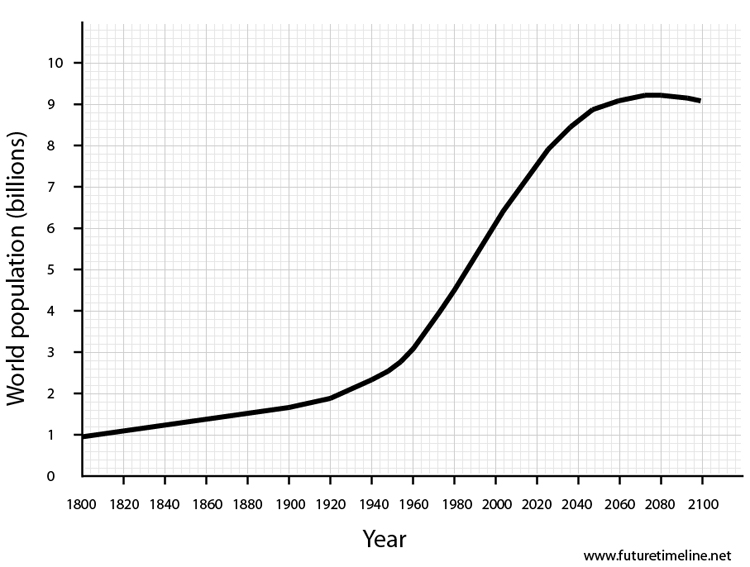
Water crisis in Europe
Due to global warming, the Alps are becoming largely devoid of snow for the first time in millions of years.*
Due to global warming, the Alps are becoming largely devoid of snow for the first time in millions of years.*
Having served a vital role as the "water towers of Europe", this is having a catastrophic effect on water supplies. Major rivers such as the Rhine, Rhone and Danube have until now relied on snow and glacial melt from the Alps. Switzerland is being especially hard hit, with much of its electricity based on hydroelectric power.
In addition, record heatwaves are causing gigantic wildfires, the likes of which have never been seen before. At the foot of the mountains, rockfalls triggered by melting permafrost have caused widespread destruction to villages and towns.* Meanwhile, the tourist industry has been decimated, with skiing impossible in most areas.
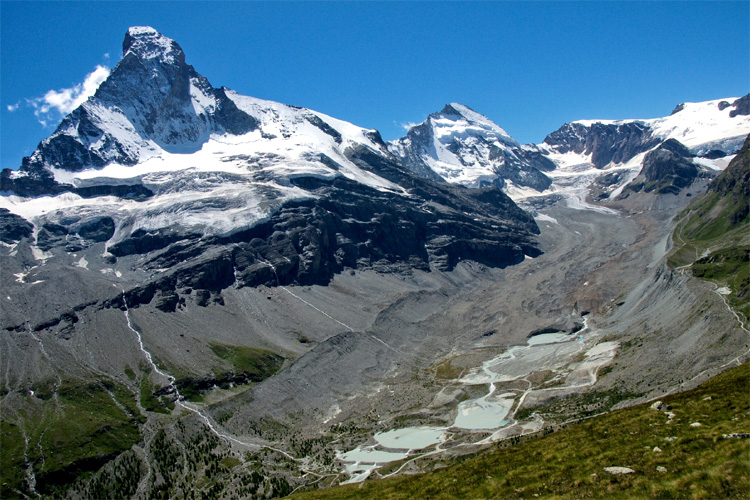
Above: The Matterhorn (left) and the Dent d'Hérens (right), part of the Alps, pictured here in 2008. Credit: Jackph
2042
Nanotech robot swarms are the latest in military hi-tech
In addition to larger machines, a new class of miniature robots is now appearing on the battlefield.* These are so small that they are barely visible to the naked eye, measuring less than a millimetre across. Viewed through a microscope, they would appear like tiny insects equipped with metallic wings and armed with diamond-sharp claws and teeth.
Individually, they are relatively harmless. However, the strength of these robots lies in their terrifying numbers, and their ability to work in autonomous networks guided by remote computers. Released from capsules dropped by UAVs, these machines are deployed in colossal swarms – often consisting of many trillions of individuals. At full spread, they can sometimes cover an area the size of a small town.
Collectively, they would appear like a diffuse, greyish cloud. For a potential enemy, the first warning sign of their approach might be a glittering of reflected sunlight in the distance. This would be followed by a high-pitched buzzing or humming sound, at the edge of the human auditory range. The next indicator would be the crumbling of trees, buildings and other nearby objects. Then the robots would attack... engulfing their victims like a swarm of locusts, eating through flesh within seconds and reducing organic material to dust.
Even those hidden within bunkers or underground shelters are vulnerable – the swarms dissolve all but the most heavily reinforced armour and can easily penetrate cracks, air vents, keyholes and the like.
In addition to their offensive capabilities, nanotech robot swarms can serve in a defensive role. By floating at low altitude in the sky, they can provide cover to advancing ground forces, acting as a shield or “buffer” against incoming projectiles.
This form of technology is so deadly that it has been placed in the same category as nuclear, chemical and biological weapons by the UN. A number of international treaties are signed over the following years, limiting its use. Safety mechanisms are also introduced, minimising its potential for adaption. Self-replicating variants, for example, are flat-out banned, as these could potentially consume the entire biosphere in a worst-case scenario. Fears are growing of a potential terrorist incident (or "nanocaust").
Manned missions to Phobos and Deimos
A decade after the Mars landings, follow-up missions to its satellites are being undertaken. Due to the low gravity and lack of atmosphere, these missions are actually easier (and cheaper) than going to Mars itself.
These tiny moons are found to contain pockets of water ice, along with carbon and silicates - greatly increasing their potential for colonisation.*
On Phobos, a series of habitation modules are subsequently built, together with small experimental mining facilities and a solar parabolic reflector. This allows the basics of carbon nanotube (CNT) production, as well as conversion of water into hydrogen and oxygen for rocket fuel. Over the next few decades, the base is expanded further, eventually becoming self-sufficient.
Both moons are colonised, but Phobos in particular will play a key role in the development of Mars, being much closer to its parent planet than Deimos. As well as supplying raw materials, it will act as a stepping stone for astronauts arriving from Earth.
Click to enlarge.

Credit: NASA
Floating hotels in the sky are heralding a new era in luxury transport*
Giant, vertical airships powered by a combination of hydrogen and solar energy are now a common method of holiday travel for the rich and famous. These ships are nearly 900ft tall when docked. They are capable of lifting 400 tons of payload, in addition to ferrying over 100 passengers and 20 crew to their destination.
Cruising at a maximum altitude of 12,000ft, the ships drift at a leisurely 60-90mph, depending on wind conditions. Popular routes include London to New York (37 hours) and Los Angeles to Shanghai (four days).
Huge internal spaces offer plentiful room for living, dining and relaxing. The lower deck contains a glass bottom floor, enabling passengers to view the land and sea beneath.
Safety is ensured thanks to self-sealing lifting bags. These are made from nanotechnology materials that minimise any potential for skin rupture.*
2044
The last veterans of WW2 are passing away
During this decade, the last surviving veterans of World War II are passing away. A small number of them reach their 120th year, allowing them to attend the 100th anniversary commemorations of D-Day, on 6th June 2044.
On this date, a time capsule is opened at the American Cemetery at Colleville-sur-Mer, close to the site of the Normandy landings which claimed so many lives. This contains press articles from the time - including a message from President Eisenhower to future generations.*

© Lenor | Dreamstime.com
2045
Humans are becoming intimately merged with machines
In some fields, the pace of technology has become so fast that humans can no longer comprehend it - unless they augment their own intelligence. This is particularly true of computing, nanotechnology, medicine and neuroscience, all of which have seen exponential progress.*
The typical home PC of today has an integrated AI system equivalent to over a billion human brains.* This machine can think for itself, communicate with its owner and suggest new ideas in ways that surpass even the greatest minds on Earth. Due to the flood of data being exchanged on the Internet and elsewhere, these computers receive literally millions of emails, status updates, news reports and other alerts each day.*
The only way for a user to interpret this avalanche of information is to merge their consciousness with the machine. A growing segment of society is now turning to on-person hardware to achieve this. The most advanced method involves the use of microscopic, wireless, implantable devices linking neural activity directly to electronic circuitry. These "nanobots" have already been used in full immersion VR and certain medical procedures. The latest versions are capable of marrying AI with human intelligence in ways that combine the best aspects of both.
No monitor or projector of any kind is required for the latest generation of computers. The nanobots instead produce a virtual image of the screen which is augmented in the user's field of vision.

Credit: sellingpix
This operating system is controlled by their thoughts - and those of the AI - running at speeds vastly greater than a real time physical version would allow. Thousands of individual actions can be initiated within a microsecond, thanks to the robust wireless connections between the nanobots and neurons.
If necessary, the user's entire sensory experience can be instantly shifted to a full immersion virtual reality. This is a popular choice for gaming and entertainment, but also has many practical applications in the world of business. Meetings and conferences can be hastily scheduled between vast numbers of participants from around the globe - sometimes with barely a few second's notice - and lasting only a few seconds in duration. Communicating at this speed is no longer possible using conventional means, which is creating an enormous divide between those who have the technology and those who don't.
For many people, nanobot implants are becoming permanent and essential - rather than temporary and optional - due to the bewildering speed and level of information now being encountered in day-to-day situations together with the explosive growth of AI. Military personnel, scientists and medical staff were among the first to take advantage of them, but mainstream society is now following.
People are merging with machines in various other ways, too. Nanobots can boost immune systems, for example - helping to exterminate pathogens. They can also regulate blood pressure, or repair some of the damage caused by the ageing process, or accelerate the healing of wounds. Cybernetic organs are now available that almost never fail and can filter deadly poisons. Brain-computer interfaces are increasingly used in middle class homes to open doors, control lighting and operate everyday appliances.
The most extreme cases of enhancement involve people opting for "decentralised" circulatory systems - along with a form of synthetic blood - reducing physical vulnerability still further. This particular option is only available to the rich, as it involves a highly complicated procedure that radically alters their internal anatomy. The end result is that a person can survive multiple gunshot wounds or other damage relatively easily. Certain politicians are taking advantage of this - especially those in unstable regions - along with gangland bosses and career criminals.
The line between man and machine is starting to blur. Later this century, there will no longer be a clear distinction.
Global food and water shortages
The demand for food and fresh water is far outstripping the supply. Climate change is devastating entire regions, turning vast areas of farmland and forest into arid desert, creating literally tens of millions of refugees. There is a great deal of conflict across the Middle East, Africa, Asia, the southern states of America, South America, and parts of southern Europe during this time.
Gulf Coast cities are being abandoned due to super hurricanes
The growing concentration of atmospheric CO2 has led to rising sea levels, a warming of coastal waters and a more volatile weather system. In the Gulf of Mexico, a new category of "super hurricane" has emerged. This is becoming a regular occurrence by now.
These extreme weather events are nightmarish in scale and intensity. At their peak, winds of nearly 200mph bring untold devastation. Even some of the most heavily reinforced buildings are destroyed. Trees are uprooted and hurled around like matchsticks, while skyscrapers visibly sway. Storm surges and flash floods travel up rivers with almost surreal speed, overwhelming defences and bringing waves thirty feet high.
Damage from these various disasters has run into hundreds of billions of dollars. A number of Gulf cities are being permanently abandoned during this time - including Houston and New Orleans.**
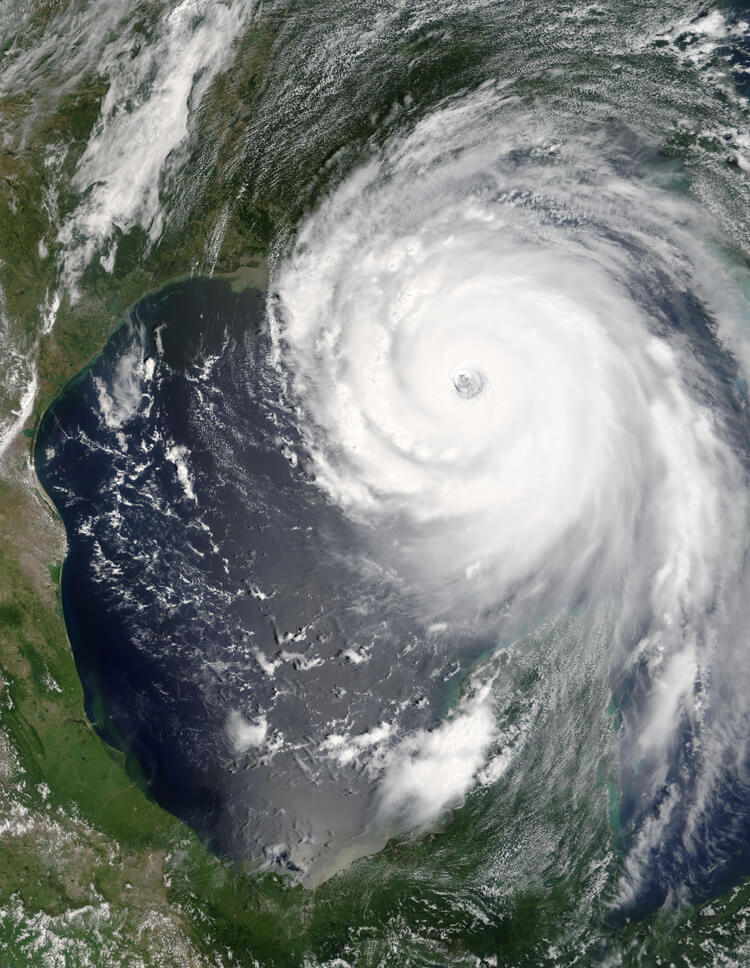
Credit: NASA
2045-2049
China transitions towards a democracy
Faced with growing social unrest, China transitions towards a Russian-style democracy. The ongoing internet/IT revolution and the resulting decentralisation of communication has brought down many of its former barriers.

Major extinctions of animal and plant life
By the end of this decade, many well-known animal species are going extinct, or else have declined in such huge numbers that only those in captivity now exist.
Off the eastern coast of Australia one of the world's most beautiful natural wonders - the Great Barrier Reef - has been virtually destroyed by climate change, with less than 2% of coral remaining.* Rising levels of greenhouse gases have made the water too acidic for calcium-based organisms to grow.* Most of the colourful fish for which the reef is famous have also disappeared. On land, more than 50% of the continent's 400 butterfly species have died out, as well as numerous reptiles including Boyd's forest dragon, a rare and colourful lizard.
In Europe, an astonishing 50% of amphibians have disappeared due to pollution, disease and loss of habitat caused by climate change. This includes many previously common species of frogs, toads, salamanders, newts and caecilians.* On the same continent, more than 20% of bird species have been lost, and around 15% of plants.
In South Africa's Kruger national park, a major conservation area, nearly 60% of the species under its protection have been lost. In the same region, 35% of proteaceae flowering plants have disappeared - including the national flower, the King Protea.*
In South America, nearly half of the Amazon rainforest has been destroyed, with more than 2,000 native tree species becoming extinct.
In Mexico, nearly 30% of animal species are either extinct, or critically endangered.
In Southeast Asia, the Indian elephant is on the brink of extinction. Once a common sight in this part of the world, it has declined in huge numbers due to poaching for the ivory of its tusks, loss of habitat, and human conflict.
In the Arctic, nearly 70% of polar bears have disappeared due to the shrinking of summer ice caused by global warming. By 2080 they will disappear from Greenland entirely, and from the northern Canadian coast, leaving only dwindling numbers in the interior Arctic archipelago.
Many other well-known species of fish, bird and mammal become critically endangered around this time.
This period is often referred to as the Holocene extinction event. As a direct result of human influences, the rate of species extinctions this century is between 100 and 1000 times the natural "background" or average extinction rates in the evolutionary time scale of Earth.
2047
Fully autonomous, intelligent military aircraft
Today's jet fighters are now entirely computer controlled. These unmanned planes have fully autonomous capability from the moment they take off, to the moment they land. A combination of strong AI, swarming behaviour and hypersonic technology is employed to create near-instantaneous effects throughout the battlespace.*
The growth of network-centric warfare and the increasing complexity of enemy types, movements and environmental factors has led to major advances in target recognition technology and collision avoidance systems. This allows whole squadrons of pilotless planes to synchronise, attack from multiple vectors and regroup in seconds. Further autonomy is provided by auto air refueling, self-repair and other systems.
With the emergence of AI, personnel costs have shifted from operations, maintenance and training, to design and development. Machines can perform repairs in-flight (including the use of "self-healing" nanotechnology composites) while routine ground maintenance requires little or no human labour, being done mostly by robots. New tactics and information can simply be programmed into the aircraft, or they can "learn" from others in the swarm.
With their hypersonic engines, inhuman reaction times and improved weaponry, these craft would run rings around human pilots of earlier decades. Following the retirement of the F-35 Lightning II, manned fighter planes are now essentially obsolete.*
2048
The Antarctic Treaty comes up for review
Antarctica is the last remaining unspoilt wilderness; untouched by the massive industrialisation common everywhere else on the planet. It covers an area of 13.7 million sq km (5.3 million sq miles) and is covered by an ice sheet 4 km (2.5 miles) deep. It has no human inhabitants, other than a small number of scientists in research stations.
The vast, icy continent is governed by the terms of the Antarctic Treaty, which came into effect in 1961. This was signed by Argentina, Australia, Chile, France, New Zealand, Norway, the UK, Belgium, Japan, South Africa, the USA and Russia. The first seven of these countries have historic claims to the continent (none of which are generally recognised) and the Treaty preserves the status quo, neither recognising nor repudiating the old claims, but forbidding their expansion in any way. The terms of the Treaty also forbid the assertion of new claims.
The discovery of a hole in the ozone layer, and other concerns, led to the addition of a new environmental protocol agreed in 1991. This entered force in 1998. It was intended to protect Antarctica's environment and ecosystems, and included a total ban on the exploitation of mineral and energy resources, as well as strict regulation of pollution and other damaging activities. The protocol is open for review in 2048, exactly 50 years after it was implemented.*
Much has changed in the last half century. Earth's population is over 50% larger. Massive industrial growth has occurred in southeast Asia - with an exponential rise in the production of vehicles, new buildings, power plants and infrastructure. Alongside this, a rampant consumerist culture (in both East and West) continues to encourage an endless expansion of people's material standard of living.
All of this has placed a substantial drain on the Earth's resources, which is becoming alarmingly obvious by now. Metal supplies in particular are falling sharply, even with large-scale recycling systems in place.* Despite objections from environmentalists, there is general consensus among the international community that some limited exploitation of Antarctica should be permitted, in certain specially controlled areas. Over the next few years, a new treaty is drawn up with a modified set of clauses, though disputes continue over territorial boundaries.
There are significant logistical challenges to mining and mineral extraction in the region - such as the isolation, extreme cold, rough seas and thick ice sheet. However, new technologies look set to mitigate these problems, including the use of robots, heavy automation and alternative methods of drilling. In addition, climate change and the melting of ice is making it possible to exploit some previously inaccessible areas of the western ice sheet.
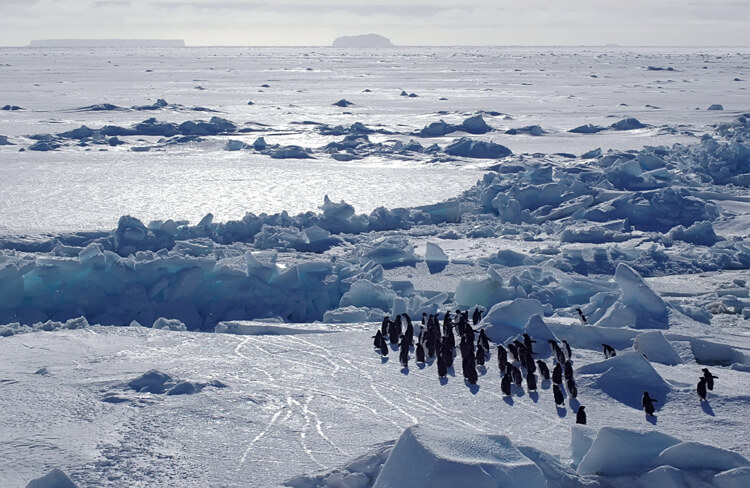
© Staphy | Dreamstime.com
Reversible biostasis is available
Nanotechnology has continued to progress exponentially, transforming society in ways that were only recently considered science fiction.** Towards the end of this decade, it's becoming possible to actually "freeze" people in a form of suspended animation. This is achieved by shutting down their metabolism and preserving cell structures, using a complex arrangement of nanobots.
These microscopic machines have been around for a while now, in a variety of roles. They are already a staple of military hardware, medical equipment, entertainment devices and general-purpose computing. This latest generation reaches a new level of sophistication. Networked together in the trillions, they are self-guided through the bloodstream and into every cell. Here, they can block the molecular machinery of metabolism and tie structures together with stabilising cross-links, held firmly in place. As water is expelled and replaced with preservative fluid, nanobots pack themselves solidly around each cell, preventing any damage or deterioration.*
Once the patient has been fully stabilised in this way, they are essentially frozen in time. They can be kept in this condition for years, if necessary. To a casual observer, they would appear cold and dead.
The procedure leads to a number of useful applications. In medicine, for example, it provides the deepest possible anaesthesia, giving surgeons unlimited time to work. It can be used for medical emergencies in remote locations, stabilising a patient's condition until help arrives. In space travel it helps future astronauts with long journeys, avoiding problems of boredom and/or food supplies. It can be used in covert spying missions, where an individual might be required to lie in a restricted space for extended periods of time. More commonly, it can be used by citizens as a life extension technology, or for personal financial reasons.
The process is reversed with cell repair machines - so only very minor damage is done, without any lasting harm. Nanobots enter the patient's tissues and remove the "packing" around cells, replacing it with water. The cross-links are then removed; any damage to structures is easily repaired. Salt, ATP and blood sugar levels are then restored. Finally, the metabolic machinery is unblocked and the patient's body rapidly comes to life again.*
The near-Earth asteroid 2007 VK184 makes a close pass
This object - measuring 130m in diameter - has a 1 in 3,000 chance of hitting the Earth on this date. It was discovered by the Catalina Sky Survey in 2007. Ignoring the acceleration of the asteroid due to the Earth's gravity, its velocity relative to the Earth at the intersection of their orbits would be 15.63 km/s.
If such an impact were to occur, it would likely break into several pieces in the atmosphere. However, these individual chunks of rock may still be large enough to cause widespread devastation, if landing in populated areas. For comparison, the Tunguska event of 1908 was thought to have been caused by an object measuring 30-50m. This was large enough to produce an airburst equivalent to thousands of Hiroshima bombs.
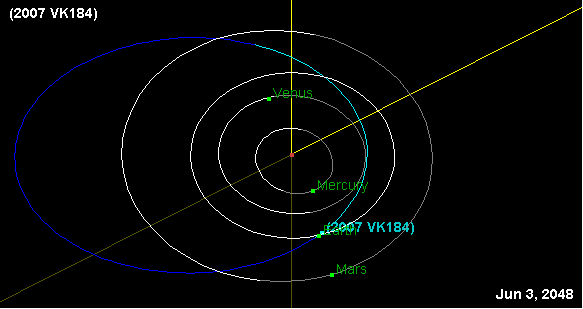
Source: JPL Small-Body Database Browser
2049
Robots are a common feature of homes and workplaces
Robots are now appearing in mainstream society in a wide variety of forms and functions.* Mobile androids are especially popular amongst the elderly, widowed and those who are disabled or incapacitated - in which role they serve as companions, guides and carers. They are also popular amongst the lonely and socially anxious, who can develop relationships without the fear or hang-ups normally associated with human company.* Those seeking "alternative" lifestyles are also making use of androids.*
Sports enthusiasts are making use of robots - as running partners, for example, on squash and tennis courts, and in certain fighting/fencing games where they can simulate world-class players. Countries such as Japan and Korea have even started broadcasting their own "Robot Olympics", attracting millions of viewers.*
The cheapest android models are available for less than $1,000 now, and are stocked by many high street retailers - including hardware stores, department stores and electronics shops. Some of the more advanced models feature lifelike skin, hair, eyes, lip movement and other features. All of the personal information required to cater for their "owner" is pre-programmed into the android's brain.
Government legislation regarding these machines is complicated - and requires years to be fully implemented - but in every country, without exception, the machines adhere to three basic laws. These were postulated almost a century earlier by the science fiction writer, Isaac Asimov:
1. A robot may not injure a human being or, through inaction, allow a human being to come to harm
2. A robot must obey orders given to it by human beings except where such orders would conflict with the First Law
3. A robot must protect its own existence as long as such protection does not conflict with the First or Second Law
2. A robot must obey orders given to it by human beings except where such orders would conflict with the First Law
3. A robot must protect its own existence as long as such protection does not conflict with the First or Second Law
In urban locations, robots are usually powered by wireless energy transfer. In more remote outdoor environments they can utilise internal super-batteries and photovoltaic polymers coated on their bodies. Piezoelectric meshes in their skins - which generate small amounts of electricity through movement - provide a tertiary source of power.
Practically every warehouse and factory in the developed world now has operations run entirely by robots - which can navigate their way through aisles and shelves, identify products and load them onto delivery vans with little or no human intervention (and at speeds and efficiencies which far outpace the latter). Even most delivery trucks are now automated, thanks to advanced AI and road traffic systems, with robots unloading goods when the vehicle has reached its destination.
One particular fad at the moment is for robot cats, dogs and other domestic pets with highly realistic movements and behaviour, often indistinguishable from the real thing. These have a number of advantages - such as never getting sick or dying, never requiring food or water, never scratching or biting their owners, and never leaving a mess around the home. Certain species of tropical fish are also popular in robot form, especially those which have recently become extinct. In museums and outdoor exhibitions, breathtaking recreations of dinosaurs and other prehistoric life are now on display.
Almost every large office and corporation features robots now - from wheeled models which distribute post, to those in reception-based roles which meet and greet visitors and assist with queries, to more advanced models capable of handling security and maintaining facilities.
In hospitals, delicate procedures involving nanotechnology devices are given over exclusively to robot machinery, capable of far greater precision than human hands.
Agriculture and food production is heavily reliant on robots. With much of the world's arable land turning to desert, hydroponic "vertical farms" are a common feature of urban centres. These carefully controlled environments are tended by robots and automated systems, and often require the analytical skills of machines rather than humans.
The physical side of military operations is handled extensively by robots now - on land, in the air, and at sea. Formidable humanoid machines equipped with a plethora of devastating firepower can be sent deep into enemy territory, left to operate autonomously for months at a time if necessary, and serving in a wide variety of roles; from solitary patrol and scouting missions, to offensive strikes involving thousands of machines working in unison. Human enemies stand little to no chance against this kind of onslaught, which is giving developed nations an overwhelming advantage over terrorist renegades.
In space, robots have probed and explored hundreds of moons in the outer solar system, and are playing a key role in the Moon colonies.
The Dead Sea is drying up
The Dead Sea is a unique geological feature. Located between Israel and Jordan, it is the lowest point on Earth. With an extremely high content of mineral salts (20%), over six times greater than any ocean, it is completely devoid of life, except for extremophile bacteria. The salts are so concentrated that swimmers can float like corks, without using a life vest. The water of the sea is also purported to relieve pain and treat several different skin conditions and arthritis. For these reasons, it has been a world famous tourist attraction.
By the late 2040s, however, the sea has almost vanished. Its main supply of water - the River Jordan to the north - has seen extensive diversions for industry, agriculture and domestic use. This has reduced its flow to just a trickle by the time it reaches the Dead Sea, far from adequate to replace the water lost by evaporation.
For decades, the Dead Sea has plummeted in depth. The problem is compounded by rising global temperatures, which have accelerated the evaporation of water; and the growing population in the region. By now, little more than a pond remains. This is despite efforts to divert water from the Mediterranean and nearby Red Sea.*
2050-2059 Contents
2050
The World in 2050
The main players in the world today are the USA, China, the EU, India, Japan, Russia and Brazil (in that order*). For China and India, the immense population of these two nations means that, per capita, their incomes remain relatively low. Nevertheless, they now wield huge economic influence.
The frantic pace of globalisation has continued. Intercultural connection is resulting in white caucasians gradually becoming a minority in the USA and elsewhere.
Radical Islam and its resentment of the West continues to produce new Jihadists. At least one terrorist nuclear attack on a major world city has been carried out by now. This occurs in the form of a well-planned "dirty bomb" on a financial district. Large amounts of nuclear material had been missing from Russia since the early 1990s, and some of this inevitably fell into the wrong hands.* Being orders of magnitude greater than 9/11, the effects of the attack leave a deep psychological scar on many people alive today, and fuel much paranoia and suspicion between nations, in addition to throwing the world's economy into turmoil for several years.
Despite this tension, progress has been achieved in cooperating on certain key issues, such as the environment. Carbon emissions have fallen substantially compared with 1990 levels - thanks to advanced nanotechnology, across-the-board improvements in energy efficiency and power conservation, widespread deployment of solar, wind and wave power, as well as 4th generation nuclear power. The depletion of oil reserves has played a part too. Fusion power is also becoming available now and is being adopted by most of the leading nations. Orbital solar power is another industry seeing major growth around this time.
However, the delayed reaction of carbon emissions from previous decades is continuing to affect weather patterns and climate stability, as is the ongoing destruction of the Earth's rainforests. Sea levels have risen over half a metre by now and are beginning to affect much of the world's coastal real estate. Many countries are now turning to large-scale carbon sequestration as a way of reversing the damage done.
Space travel has taken a big leap forward by this time, with greatly reduced launch costs allowing a much greater frequency of flights.* Substantially heavier payloads can also be lifted into orbit. Space tourism is becoming relatively commonplace, with even middle-income citizens enjoying orbital flights. For the super-rich, lunar orbits and even brief excursions to the Moon's surface are becoming possible.
The first permanent scientific station is being planned for Mars now. Meanwhile, talks are underway to develop the first space elevator, which will be anchored in Australia. Commercial asteroid mining is being studied as a long term option by the US, China, Japan and the EU. Progress is being made with nuclear pulse propulsion - bringing the manned exploration of the outer solar system closer to reality.
The largest space-based telescopes of today can directly view extrasolar planets in detail and establish facts about their geology and climate.
45% of the Amazon rainforest has been destroyed
Lack of enforcement in the so-called protected areas has resulted in the Amazon undergoing a catastrophic decline. The government sent army troups into regions of illegal deforestation, but the numbers of soldiers were simply too small, and the Amazon rainforest too vast, to have much impact.
Political support from organisations of farmers has also diminished, while corruption amongst government personnel has been another factor.
Droughts caused by global warming have also contributed to the gradual decline of the rainforest, with many areas of jungle turned into virtual deserts.
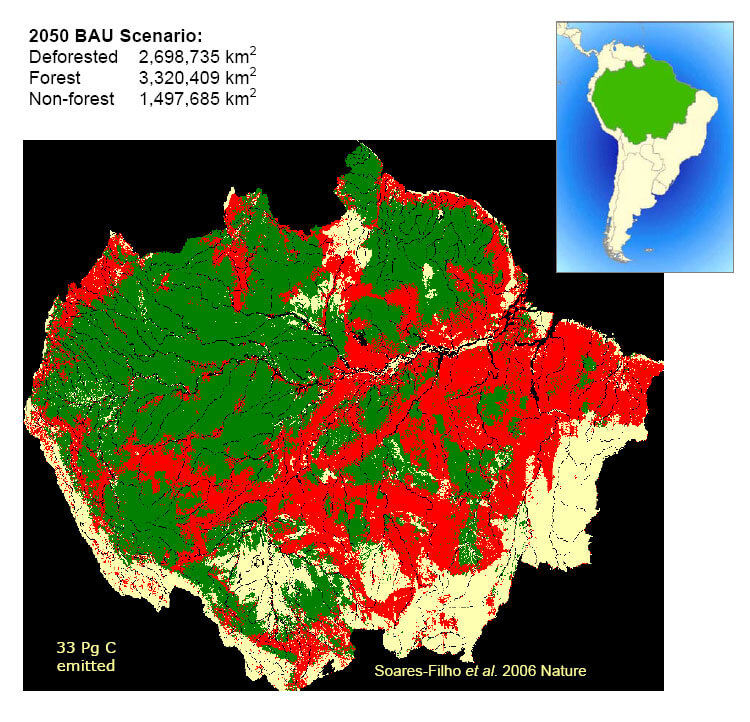
As a result, an extra 30 billion tons of carbon have been added to the atmosphere. Although the clean energy sources described earlier have offset this, it can't save the many thousands of species of plant and animal life which depend on the rainforest for survival. A huge amount of biodiversity is lost during this time. Desperate efforts are made by non-profit organisations to obtain DNA samples, in the hope of resurrecting these species at some point in the future.

Above: A red-eyed tree frog
Wildfires have tripled in some regions; air quality and visibility is declining
Rising global temperatures are creating drier conditions for vegetation - producing larger and more frequent wildfires. In North America, the geographic area typically burned has increased by an average of 50%. Worst hit are the forests of the Pacific Northwest and the Rocky Mountains, which have seen a tripling of areas affected.*
With so much extra burning, the air quality and visibility throughout the western USA is being significantly altered. There has been a 40% rise in organic carbon aerosols and other smoke particles.* These irritate the lungs, but are especially dangerous to people who have trouble breathing as a result of asthma and other chronic conditions.
Southern Europe is also particularly affected - especially Greece, which has been ravaged in recent decades.*
These wildfires are triggering positive feedback loops. Since they pump more and more greenhouse gases into the atmosphere, this is further accelerating the pace of global warming.
Substantial economic damage is now being caused to a number of countries, while insurance premiums are soaring.
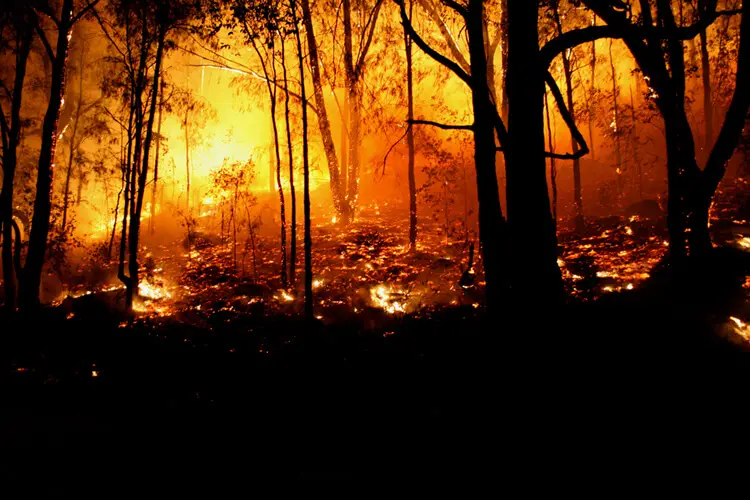
Credit: Roger Rosentreter
Smaller, faster, hi-tech automobiles
Soaring living costs - along with exhorbitant taxes and measures relating to the environment - have led to cars and other vehicles evolving into smaller, cheaper, more energy-efficient designs.
More people than ever before are choosing to live and work alone, while the number of children per couple has also dropped sharply; two additional factors which have led to these lighter, more compact vehicles - a large percentage of which carry no more than one or two passengers.
Nearly all cars in the developed world are now computer-controlled, while traffic flow and road management issues are handled by advanced networks of AI. The resulting fall in congestion has boosted some economies by tens of billions of dollars.
The inherent safety of being controlled by machine, rather than human hands, allows for much greater speed of travel: over 200mph on some motorways. Even when crashes do occur, which is extraordinarily rare, the built-in safety features and toughened materials (including the use of carbon nanotubes) means that fatalaties are becoming virtually non-existent.
Meanwhile, a number of the largest automakers are conducting long term research into hovering/flying vehicles, based on existing military technology.
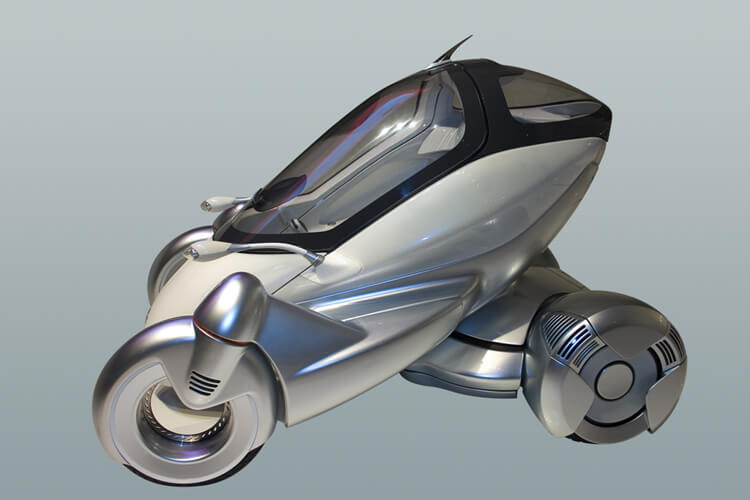
A typical mid-range car of 2050.
Continent-wide "supergrids" provide much of the world's energy needs
The need for reliable, clean, cost-effective energy has led to the creation of electrical "supergrids" across much of the world.* These allow nations to share power from abundant green sources and distribute it to those regions most in need. By cooperating in this way, it is possible to substantially reduce waste and to optimise power supplies on a continent-wide scale, at all times of the year.
For instance, winter gales in the North Sea can provide a surplus of wind power, which is complemented by the summer winds of Morocco and Egypt. Meanwhile, solar panels in northern Africa generate three times the electricity compared with the same panels in northern Europe, due to the greater intensity of sunlight. Up to 100 GW of power is being supplied from Africa to Europe in this way.*
Similar large-scale infrastructure is now in place throughout America, Asia and other parts of the world.
Long distance transmission technology has seen major advances over the decades. Each country is connected to the grid using high-voltage direct current (HVDC) transmission, instead of traditional alternating current (AC) lines. This results in far greater efficiency, since DC lines have much lower electrical losses over long distances.
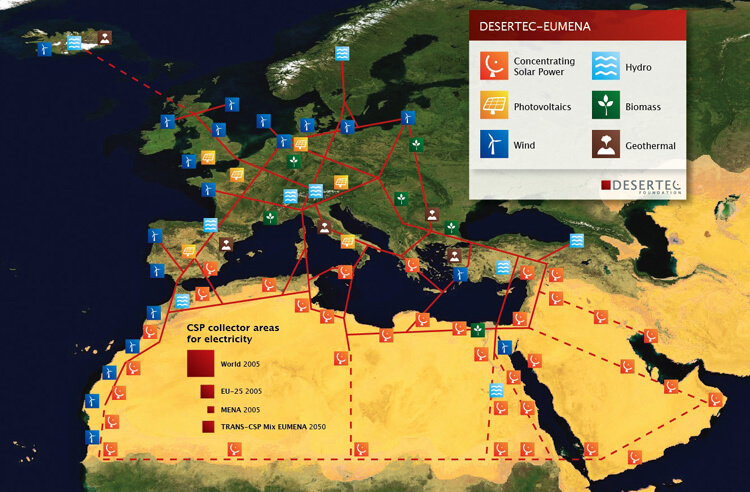
Source: DESERTEC Foundation
One in five Europeans is a Muslim
At the start of this century, less than 5% of the EU's population was Muslim. By the early 2050s, this figure has risen to over 20% - due to a combination of soaring immigration from Muslim countries and record low birth rates among Europe's indigenous population.*
Britain, Spain and Holland have an even higher percentage. These countries, in particular, are going through significant changes to their culture, education, housing, economic and foreign policies. This is creating a great deal of social unrest.*
This demographic sea change will continue, with some EU countries becoming majority Muslim by 2100. However, a significant percentage will be only "culturally" Muslim - rather than having a literal interpretation of the Koran - as mainstream Islam begins a reformation and modernisation.
2051
Britain holds its centennial national exhibition
A centennial national exhibition is held in the UK - in keeping with the precedent set by the Great Exhibition of 1851and the 1951 Festival of Britain. The opening ceremony is attended by King William V, now aged 69.
Technology features heavily in this exhibition. There are many exotic devices, structures and buildings on display - all designed to showcase Britain. Despite its ongoing social problems, the country remains a leading centre of science, design and innovation.
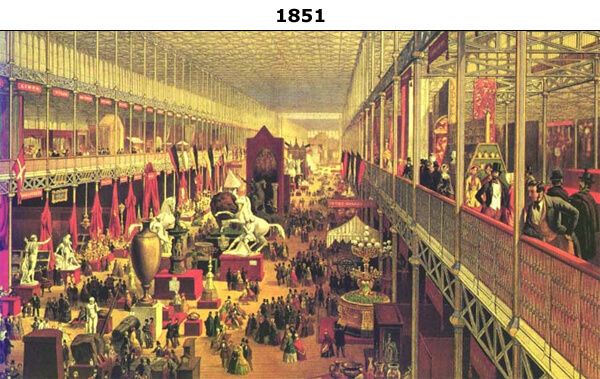

2052
Hyper-fast crime scene analysis
Crime scene analysis and forensic science is becoming extraordinarily rapid and sophisticated, thanks to the convergence of a bewildering array of technologies. Investigations that might have taken hours, days or weeks in earlier decades can now be completed in a matter of minutes.
On-person devices - combining Augmented Reality, nanotechnology, pattern recognition software, AI programs and vast online databases - are turning the average FBI officer into a walking laboratory.
DNA scanning in particular has seen major breakthroughs in recent years. Genetic material can now be decoded almost instantly,* using special touch-sensitive gloves.
2053
Moore's Law reaches stunning new levels
Due to Moore's Law, desktop PCs now have AI systems equivalent to all of the human brains on Earth combined.
It is becoming difficult to distinguish human from machine intelligence, with online services now host to entities of astonishing realism and interactivity. Many programs are in fact merging with human intelligence, as the drive towards brain-computer links increases - fueled by the breakneck pace of the global economy and the need for hyperfast exchange of information.
With such raw computational power available, the consumer market has been revolutionised. Video games of today provide fantastically lifelike simulations, with deep levels of interaction.
Although full immersion VR has been available for a while now, recent advances in AI have led to Matrix-style worlds of breathtaking scale and ingenuity. Entire new societies are forming in cyberspace, with many in developed nations spending their entire leisure time engaged in them. Mounting stresses from the outside world have also served to increase demand for this form of recreation: as a means of escaping from reality itself.
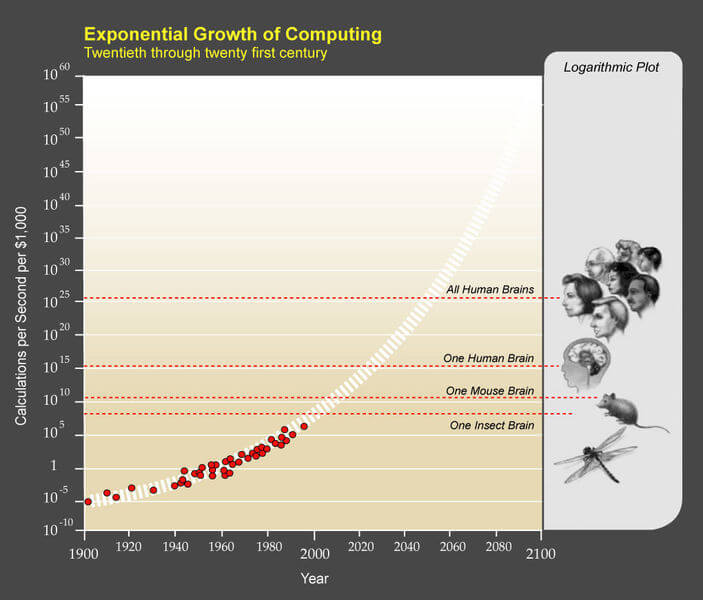
Credit: Ray Kurzweil
Genetically engineered "designer babies" for the rich
The ability to manipulate DNA has come a long way since its discovery in 1953. A century on, wealthy parents now have the option of creating "perfect" babies in the laboratory. This is done by picking and choosing their best hereditary traits. Gender, height, skin, hair and eye colour - along with hundreds of other characteristics - can be programmed into the embryo prior to birth. The embryo is then grown in an artificial uterus.*
The most advanced (and controversial) techniques involve manipulating the brain to improve the child's intelligence, behaviour and personality. Many conservative and religious groups decry what they see as the commercialisation of the human body.
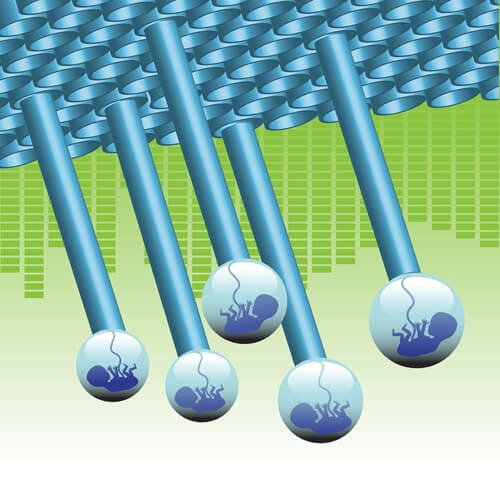
© Oxlock | Dreamstime.com
2055
Traditional media have fragmented and diversified
By now, traditional Western news corporations no longer exist. News gathering, analysis and distribution has instead fragmented - shifting to millions of creative individuals, bloggers, citizen journalists and small-scale enterprises. Each of these works cooperatively and seamlessly, utilising a "global commons" of instantly shared knowledge and freely available resources. This includes information retrieval not only from cyberspace but also the real world; embedded in everything from webcams and personal digital devices, to orbiting satellites, robots, vehicles, roads, street lamps, buildings, stadia and other public places.
Even people themselves have become a part of this collection process. Bionic eye implants (for example) can relay data and footage on the spot, in real time, from those willing to participate.
Traditional Western TV channels have largely disappeared, replaced by unique "personalised" web channels, covering practically any subject or combination of subjects imaginable. These are filtered and customised to the exact tastes and requirements of the individual and are viewable anywhere, at anytime. They can be highly interactive and are often experienced in virtual reality settings, rather than on a screen. This is especially true of movies, many of which have non-linear plotlines allowing the viewer to influence the outcome themselves, or even to become characters within the film.
Mass advertising, too, has undergone a revolution in Western societies. Some of the oldest outdoor media still exist - such as posters, billboards and leaflets - which continue to survive in holographic and other forms. However, online web and televisual product/service information is now accessed almost entirely from on-demand, advanced customer feedback networks along with automated, semantic web assistants. Together these can provide instant, factual and trustworthy information on a highly personalised level: automatically filtering any marketing bias or corporate propaganda which might have influenced a consumer in the past.
Despite the increased choice and empowerment, one major consequence of this fragmentation (a trend which began in the 1980s) has been increased isolation of the individual. A decrease in the shared experience of media has led to a further decline in Western family and community life.
Poorer nations are still reliant on traditional forms of media gathering and information dissemination. However, in the decades to come, many of them will begin to make the transition too - thanks to exponential trends in price performance and improved access to web technology.
Global population plateaus at 9 billion
The global population has reached over 9 billion by now.* The population is also getting older, putting a huge strain on government welfare systems, labour supply and employment. Nearly a quarter of the planet is aged over 60 now - and with so many breakthroughs in medicine, this trend will only continue.
The global population has reached over 9 billion by now.* The population is also getting older, putting a huge strain on government welfare systems, labour supply and employment. Nearly a quarter of the planet is aged over 60 now - and with so many breakthroughs in medicine, this trend will only continue.
As has long been the case, most of the population growth has occurred in the developing world. However, better education along with improved access to contraception and other birth control methods is having a significant effect on reducing the number of children per couple.
The world's population is therefore beginning to level off and plateau.
Damage inflicted by climate change is also having an effect now, with vast numbers killed by drought, flooding, hurricanes and other extreme weather events; not to mention disease, lack of resources and various ongoing wars. The humanitarian crises of past decades are beginning to look modest by comparison, as whole swathes of Africa are now becoming essentially uninhabitable. Much of the Middle East, too, is facing complete collapse.
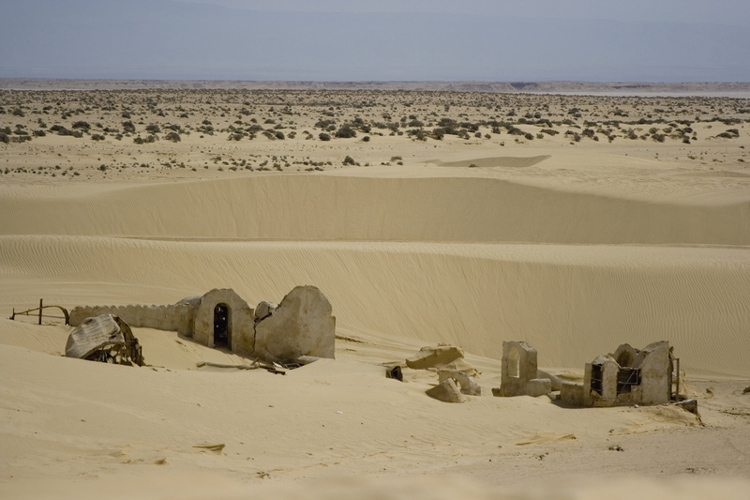
© Pac | Dreamstime.com
Over the next few decades, droughts will increase tenfold,* making agriculture impossible for many regions. In other parts of the globe, intense tropical storms have inundated cities. Everywhere, there are people being caught up in resource wars and other conflicts. Enormous shantytowns begin to form in some regions, as tens of millions are displaced.* Poverty and crime are rife in Africa, South America, and parts of southern Asia. Many of these places are so destitute that they are being reclassified as "fourth world" countries.* Pollution has also contributed to large numbers of deaths, especially in Asia.
Over two-thirds of people live in urban areas by this time,* and there are vast, sprawling megacities in all corners of the globe. In the very densest parts of the developed world, some of the tallest skyscrapers reach kilometres in height, are occupied by millions of people, and are effectively becoming cities in their own right with self-sufficient energy and food production. Many residents within these gleaming towers spend almost their whole lives in these buildings, with little need or want to venture outside.
The population of the USA has reached nearly 450 million now (up from 309 million in 2010), with Hispanics more than doubling their share of the population to 29%, and Asians going from 5% to 9%. Whites who are not Hispanic have become a minority, with their share dropping to 47%. They made up 85% of the population in 1960.* Due to climate change, most of the population growth has occured in the north-eastern states, which have better access to water and are generally more stable. California, Arizona, New Mexico and Texas have seen massive declines in wealth and influence.
2056
Fully synthetic humans are becoming technically feasible
In 2010, scientists created the first synthetic cell. Mycoplasma laboratorium was an entirely new species of bacterium, with a man-made set of genetic code, placed on a synthetic chromosome inside an empty cell. Using its new "software", the cell could generate proteins and produce new cells.*
In 2010, scientists created the first synthetic cell. Mycoplasma laboratorium was an entirely new species of bacterium, with a man-made set of genetic code, placed on a synthetic chromosome inside an empty cell. Using its new "software", the cell could generate proteins and produce new cells.*
This was followed in subsequent years by a variety of specialised organisms. Some were able to generate new vaccines and medicines; others produced biofuels and similarly useful products.
As the decades went by, larger and more complex life forms were created in the laboratory, including multi-celled animals large enough to be seen by the naked eye.
Synthetic genomics continued to advance exponentially, driven by the breakneck pace of information technology. Large animals - variants of birds, fish and mammals - became available with fully customisable limbs, sensory organs and other features, for use in a variety of commercial, scientific and industrial roles. New plants were created too, some with bizarre yet extremely useful abilities. Certain trees, for example, could be programmed to grow and shape themselves into furniture or building components.
By 2056, the number of cells that can be synthesised in a single organism has reached 100 trillion: equal to the total number in the human body.* Debates are occurring over the potential for "synthetic people" entering the population. What rights and freedoms would they have? Countless moral, ethical and legal arguments are raised.
For now, the vast majority of countries are unable to authorise the technology; the cultural lag is simply too great. Just as stem cells were controversial in the USA during the early 2000s, the creation of synthetic humans represents science advancing faster than many people are willing to accept.
However, a small number of countries - notably China - secretly push ahead with the project. Test subjects are successfully created, then made to take part in biotechnology experiments. Although hidden from public view, rumours begin to emerge of horrific abuses.*
2057
Computers reach another milestone
Individual PCs of today have AI systems equivalent to all of the human brains which ever existed on Earth.*This is a result of Moore's Law - the trend in computer processing power which has been increasing exponentially for over a century.
Individual PCs of today have AI systems equivalent to all of the human brains which ever existed on Earth.*This is a result of Moore's Law - the trend in computer processing power which has been increasing exponentially for over a century.
Computers are becoming so powerful that many high-level tasks in business and government are being handed over directly to them. For years, software had lagged behind hardware in development, which impeded the spread of AI, but this is no longer the case. Ever more sophisticated programs have begun to create a chain reaction of self improvement cycles. This has led to an "intelligence explosion", with some of the biggest political decisions on the world stage now being influenced by sentient machines.
Of course, there are controls and regulations in place to guide these actions (to prevent the use of nuclear missiles for example). Nevertheless, it is becoming obvious to everyone by now that machines are quite literally taking over the world.
Handheld MRI scanners
The ability to scan, analyse and diagnose the body has taken a huge leap forward by now. Hi-res, 3D imaging of internal structures and brain activity is now possible using real-time video rather than static photos. This can be accomplished with devices no bigger than a camera.*
In the early 2000s, these machines were so bulky that they filled whole rooms.* Scans typically required half an hour or longer to create. They were also highly expensive: upwards of a million dollars for a state-of-the-art model, with each individual scan costing hundreds of dollars.
A new generation of machines began to evolve, based on supersensitive atomic magnetometers, able to detect the tiniest magnetic fields. These replaced the huge doughnut-shaped magnets that had been used in the past. By the late 2050s, MRI scans had become as quick and easy as taking a photograph, with a hundredfold decrease in cost.*Healthcare programs in developing countries would benefit particularly from this.
2058
Construction of a radio telescope on the Moon*
The telescope is 100m wide and located on the Moon's far side, giving it a stable platform with slow rotation rate (0.5 arcsec/sec), beyond the interference of Earth's atmosphere and cluttered radio background.* This provides astronomical images with a clarity unmatched by any observatory on Earth or in space. Individual stars, billions of light years away, can be seen assembling into the first galaxies.
The telescope is situated within an impact crater. Both it and the surrounding infrastructure are built using a mixture of epoxy, self-assembling carbon nanotubes and material from the Moon itself - drastically reducing costs.*
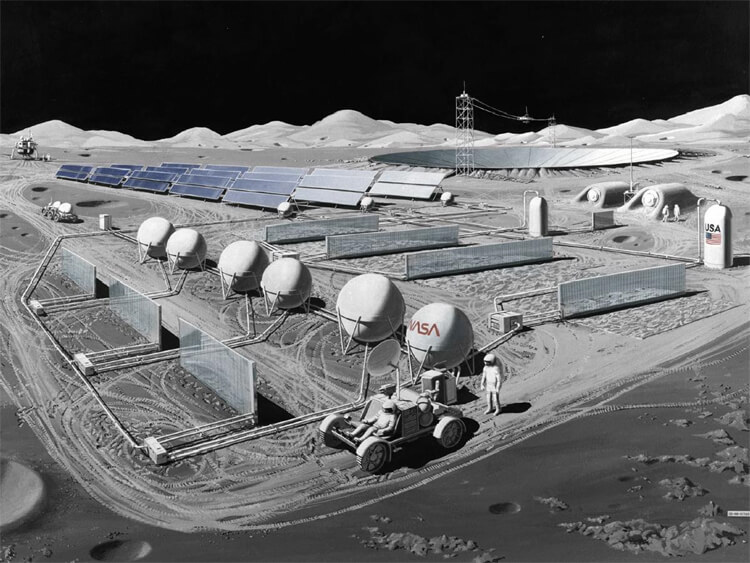
Credit: NASA
2059
Mars has a permanent human presence by now
By the end of this decade, a permanent team of scientists is present on Mars. They number around a dozen and comprise a highly international mix of people. Some will be stationed here for so long, they will eventually come to consider it their permanent home.*
The first civilian tourist has also arrived. Travel to Mars was made cheaper, faster and easier thanks to the development of nuclear pulse propulsion. This cut journey times to just a few weeks.*
The base will soon be expanded with new facilities including a larger power plant, mining equipment, nanofabricators, farms and greenhouses.* Vehicles are also being supplied to improve the astronauts' mobility, allowing them to roam hundreds of miles from the base. Additional bases are already being planned, to accomodate larger teams of scientists, as well as corporate interests.
The habitat modules are constructed partially underground, to give protection from the ultraviolet glare of the Sun. Meanwhile, radiation-absorbing materials based on advanced nanotechnology are used in spacesuits, as well as on the exterior of the vehicles. These same materials have special filters to block even the tiniest particles of dust, giving long term protection against the environment outside.
All of the above is providing the critical mass needed for self-sufficiency. Operations will soon be conducted entirely independent of Earth.
In the coming years, the first children will be born on Mars.
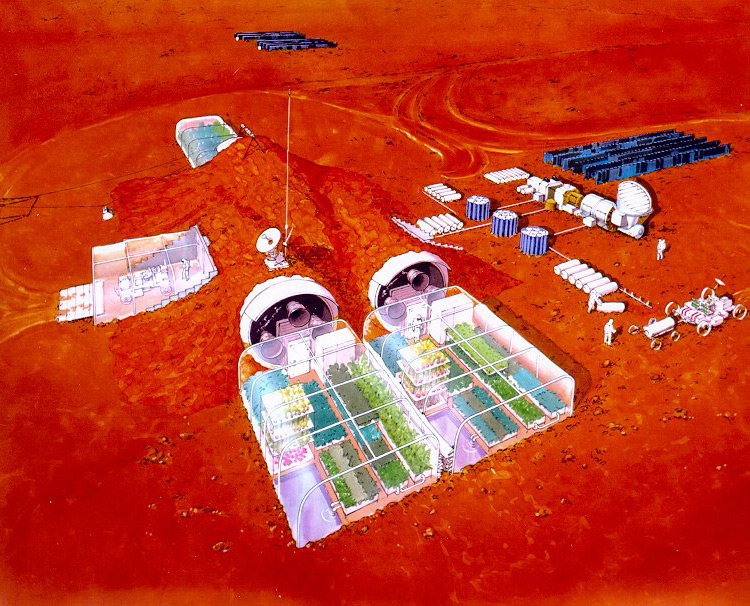 Source: NASA
Source: NASA2060-2069 Contents
2060
Global mass migrations of refugees
As the world enters the second half of the 21st century, equatorial regions are being abandoned by many people as climate change wreaks havoc on the environment. Large swathes of Africa, the Middle East, Southern Asia, Southern Europe and Latin America are being ravaged by a combination of severe drought, creeping desertification, torrential flooding and sea level rises.*
As the world enters the second half of the 21st century, equatorial regions are being abandoned by many people as climate change wreaks havoc on the environment. Large swathes of Africa, the Middle East, Southern Asia, Southern Europe and Latin America are being ravaged by a combination of severe drought, creeping desertification, torrential flooding and sea level rises.*
Mass migrations of refugees - the likes of which have never been seen before - dominate the news channels. With many areas becoming essentially uninhabitable, hundreds of millions attempt to resettle in more northerly and southerly latitudes over the subsequent decades. Once thriving cities like Dubai are turned into virtual ghost towns, while coastal cities lacking adequate defences are inundated by rising sea levels.
In Europe, many are looking to Britain as a "lifeboat", which, despite being subject to increasingly volatile weather, is relatively stable compared to the likes of Spain, Italy and the Balkans.* A similar situation is occurring in Canada, which has actually prospered from climate change due to improved agriculture and precipitation. It now faces a massive wave of immigrants from the USA, Mexico and elsewhere.
Localised conflicts over food, territory and resources are erupting around the world during this time. This is causing devastation on a scale not seen since the Second World War.*
Flood barriers erected in New York
Sea level rises and storm surges have begun to threaten even the business, financial and cultural heart of America. By 2060, what used to be a once-in-a-century type of flood is becoming a regular occurence.* This has led to the construction of sea walls, breakwaters and locks to the south of Manhattan, including one very big lock at the harbour entrance.* JFK Airport and other parts of the island are receiving protection too.
Sea level rises and storm surges have begun to threaten even the business, financial and cultural heart of America. By 2060, what used to be a once-in-a-century type of flood is becoming a regular occurence.* This has led to the construction of sea walls, breakwaters and locks to the south of Manhattan, including one very big lock at the harbour entrance.* JFK Airport and other parts of the island are receiving protection too.
This is one of the largest public works projects in US history, and comes at enormous cost. However, the costs ofnot acting would have been even greater.
Many other cities around the world are beginning to enact similar measures now.
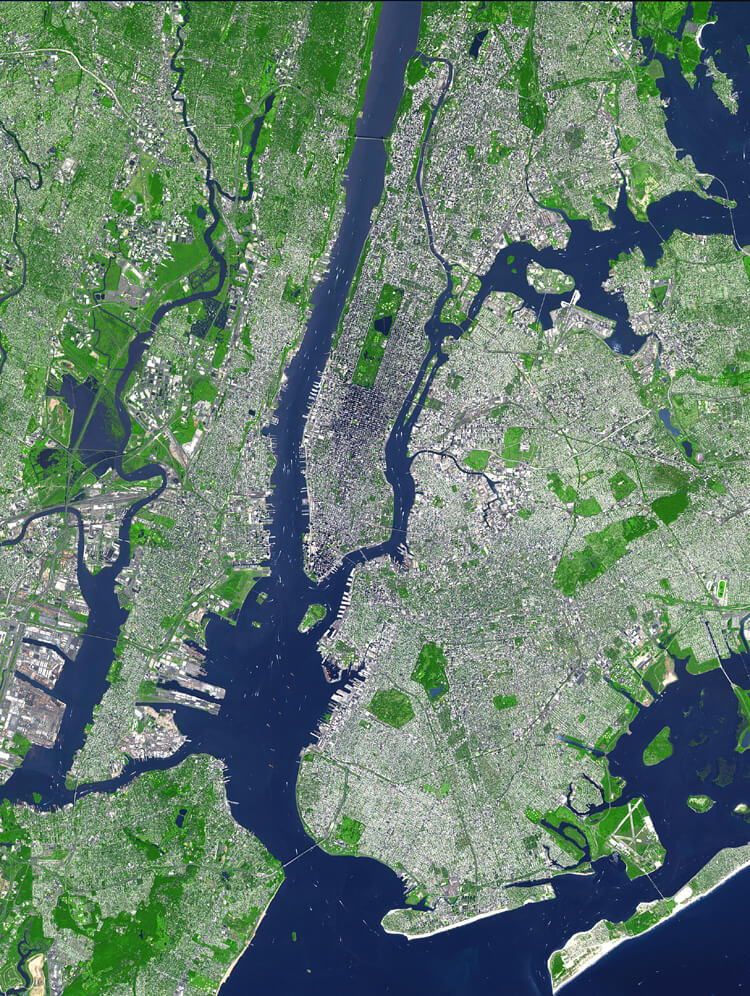
Credit: NASA
Global extinction rates are peaking
Environmental destruction is reaching its apex now, with 0.5% of the world's animal and plant species going extinct per year - nearly ten times the rate seen in 2000.* The rainforests are being especially hard hit, with a number of beautiful and iconic species dying out. As a result of so much tree loss, the level of carbon dioxide in the atmosphere is triggering positive feedback loops, leading to accelerated global warming.
Environmental destruction is reaching its apex now, with 0.5% of the world's animal and plant species going extinct per year - nearly ten times the rate seen in 2000.* The rainforests are being especially hard hit, with a number of beautiful and iconic species dying out. As a result of so much tree loss, the level of carbon dioxide in the atmosphere is triggering positive feedback loops, leading to accelerated global warming.
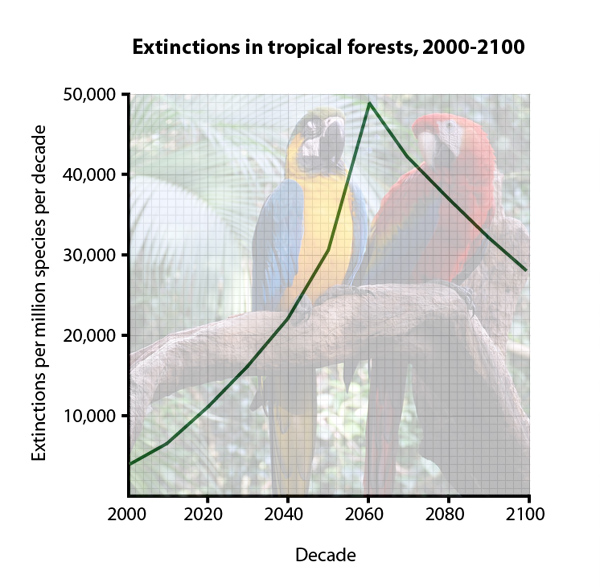
Credit: Thomas Heinz
An ageing population
In the early 21st century, around one in five of the European population was aged over 65. This meant that the pension costs, public health and transportation needs (and sometimes the housing and social-welfare requirements) of each senior citizen were supported by taxes and other deductions from the incomes of four working-age people (aged 15 to 64).
In the early 21st century, around one in five of the European population was aged over 65. This meant that the pension costs, public health and transportation needs (and sometimes the housing and social-welfare requirements) of each senior citizen were supported by taxes and other deductions from the incomes of four working-age people (aged 15 to 64).
However, birth rates stayed low throughout the first half and into the second half of the century, whilst longevity was extending through better medicine, genetic therapy, nanotechnology, improved lifestyles and so on. This meant the ratio of young to old began to shrink tremendously. By 2060 there are 50m fewer workers and 67m more seniors, so the ratio is changed to one in three - in other words, only two working-age people to support each senior.
This has impacted hugely on government budgets, leading to a radical overhaul of social welfare. A similar pattern is emerging in other parts of the world.
The problem of labour supply (or lack thereof) is being mitigated somewhat by the increased use of robots and AI, but is still presenting challenges in the short term.
Mining operations on the Moon
A number of private ventures have begun to conduct the first mining operations on the Moon. One of the principle resources for extraction is Helium-3, for use in the reactors of fusion power plants. This material is rare on Earth, but plentiful on the lunar surface. It is exceedingly valuable - a single shuttle-load is enough to power an entire country for several months.
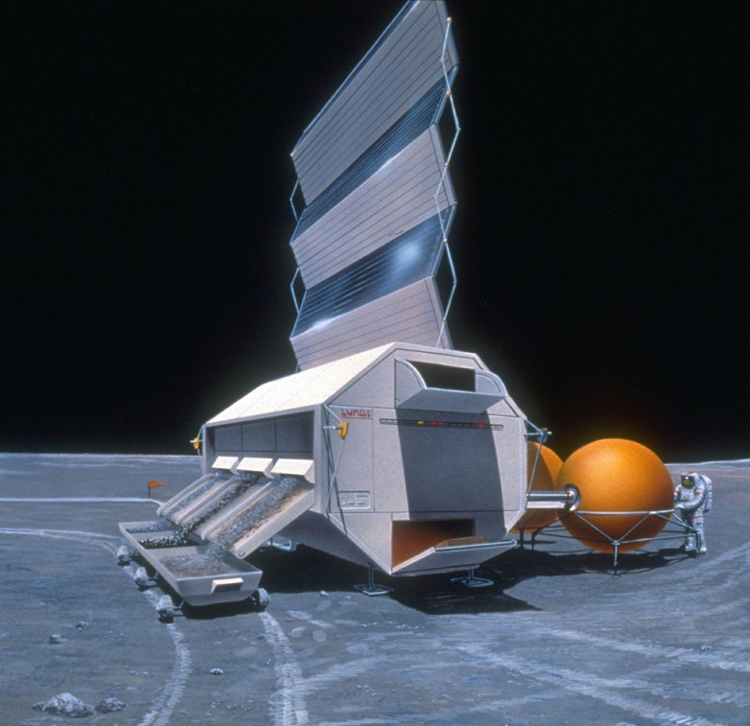
Credit: NASA
2061
Halley's Comet returns
The most famous of the periodic comets, Halley's Comet last appeared in the inner solar system in 1986. Like most comets, it has a highly elliptical orbit - taking it close to the Sun for only a short time. Several unmanned probes are sent to explore it during this year, including the first robotic lander.
The most famous of the periodic comets, Halley's Comet last appeared in the inner solar system in 1986. Like most comets, it has a highly elliptical orbit - taking it close to the Sun for only a short time. Several unmanned probes are sent to explore it during this year, including the first robotic lander.

Credit: NASA
The population of Europe, as a whole, has been declining since the 2030s. However, strong growth from immigration and a younger average population - combined with favourable environmental conditions - have allowed the UK to prosper and become the leading economic power in the region.
The country's ethnic makeup has changed dramatically over the last 50 years, becoming far more diverse and geographically integrated. In particular, black and Asian persons in the most affluent areas have greatly increased.*
London has become a true mega-city. Its urban population (in the continuous built-up area surrounding the city) has swelled to almost 12m, while its total metropolitan area now encompasses the entire southern half of England. An extensive network of high speed maglev joins its various satellite cities.
A number of huge infrastructure projects are now being planned for other parts of the UK. This includes a series of tunnels spanning the Irish Sea.*
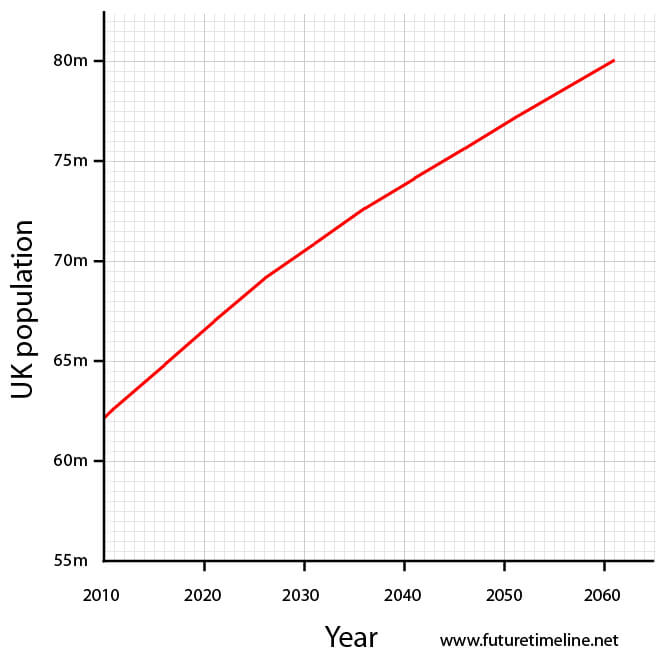
2062
Nanofabricators enter the consumer market*
These all-purpose, desktop machines can reproduce a seemingly infinite variety of items. In effect, they are like miniature factories. They have been around for a while in certain military/corporate/medical environments, but are now filtering down to mainstream use.
These all-purpose, desktop machines can reproduce a seemingly infinite variety of items. In effect, they are like miniature factories. They have been around for a while in certain military/corporate/medical environments, but are now filtering down to mainstream use.
In appearance, they have a combined washing machine/microwave oven form-factor. Raw materials are purchased separately, and can be loaded in solid, liquid or powder form. An interior compartment is accessed via a small hatch, where the objects are constructed atom-by-atom. The process takes a matter of minutes and the assembled items can be used immediately.
Electronic paper and circuitry, tools and equipment, replacement window panes, sheets of fabric, entire laptops... these are just some of the countless items available for nanofabrication. New schematics can be accessed from the web and programmed into the machine.
2064
IT's share of the US economy reaches 20%
The trend in Information Technology growth is shown below. This has been consistent since the 1970s with no signs of it slowing down.* Major industries fueling this growth now include biotechnology, nanotechnology, robotics, leisure and entertainment (especially VR and related technologies).
By the end of this century, over a quarter of America's GDP will be based on IT, as the demand for physical goods and services decreases - being replaced with virtual and digital goods and services online.
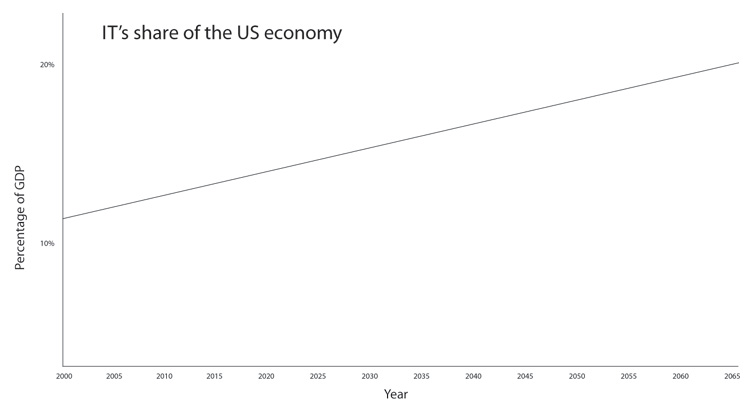
2065
Longevity treatments that can halt aging
By the middle of this decade, treatments are becoming available which can effectively halt the aging process altogether. This landmark in the field of gerontology has been achieved through a worldwide collaborative effort between thousands of universities, research institutes and scientific bodies.
Rather than being a single process, aging was found to be caused by seven key types of damage.*
1. Junk - inside cells
2. Junk - outside cells
3. Cells - too few being produced
4. Cells - too many being produced
5. Mutations - chromosomes
6. Mutations - mitochondria
7. Protein crosslinks
2. Junk - outside cells
3. Cells - too few being produced
4. Cells - too many being produced
5. Mutations - chromosomes
6. Mutations - mitochondria
7. Protein crosslinks
Various combinations of drugs were developed in order to combat these types of damage. In 2010, it was possible to slow aging by only two months per year. Over the subsequent decades, however, exponential progress was made thanks to the growth of information technology in medicine, combined with advances in nanotechnology which led to ever smaller and more sophisticated treatments. The use of nanobots - able to repair and restructure cells on a molecular level - meant the required "escape velocity" of twelve months per year was eventually reached.
Much debate rages over the morality of this treatment and its consequences for the world's population (especially from conservatives and religious groups), but there is generally strong support from the public. Following clinical trials and government approval, it is now available to the mass market.
Initially expensive, it is regarded as a luxury - in the same way that plastic surgery, laser eye surgery and other cosmetic procedures were viewed in earlier decades. However, the massive amount of public interest leads to intense competition between the pharmaceutical firms, which soon drives down costs. Further refinement makes it possible to treat aging with just a single operation, rather than multiple ongoing treatments. Even further refinement makes it possible not only to halt the aging process, but to actually reverse it. By the early 22nd century, even people over 100 begin to appear physically indistinguishable from those in their 30s.

Self-assembling buildings made entirely from nanotech
Nanotechnology - the control of matter on an atom-by-atom basis - has swept the world, transforming society in myriad ways.* At the same time, new methods of automation are displacing the need for human labour on ever increasing scales. A growing number of industries have seen their workforce shrink dramatically, with robots and AI handling the bulk of operations. Unemployment is soaring around the world during this time.
Nanotechnology - the control of matter on an atom-by-atom basis - has swept the world, transforming society in myriad ways.* At the same time, new methods of automation are displacing the need for human labour on ever increasing scales. A growing number of industries have seen their workforce shrink dramatically, with robots and AI handling the bulk of operations. Unemployment is soaring around the world during this time.
Now, even construction companies are being affected. By the middle of this decade, it's becoming possible to build entire homes and offices using nanotechnology alone. For a typical square or rectangular plot of land, this takes the form of self-assembling machinery, based around a scaffold system that initially resembles a giant, four poster bed. Vertical columns, one in each corner of the site, support a platform that gradually rises from the ground, adding successive layers of material beneath it. The columns rise in tandem with the platform, whilst also relaying material, until the building is finally topped out.
In effect, these machines are like substantially bigger versions of 3D printers and nanofabricators. For some of the more "unique" building designs or features, traditional methods of construction and engineering are still incorporated. Even these will eventually be replaced by self-assemblers as the technology advances further.
Atom by atom, these intelligent machines lay the foundations, core, framework, flooring, electrics, doors and other components - while robots inspect the interior, perform safety checks and make adjustments where necessary.
By the 2070s, even skyscrapers and other tall structures can be erected using this method. The process is so rapid, it takes a matter of weeks from groundwork to final completion - or days, in some cases. Humans are rarely if ever needed on site.
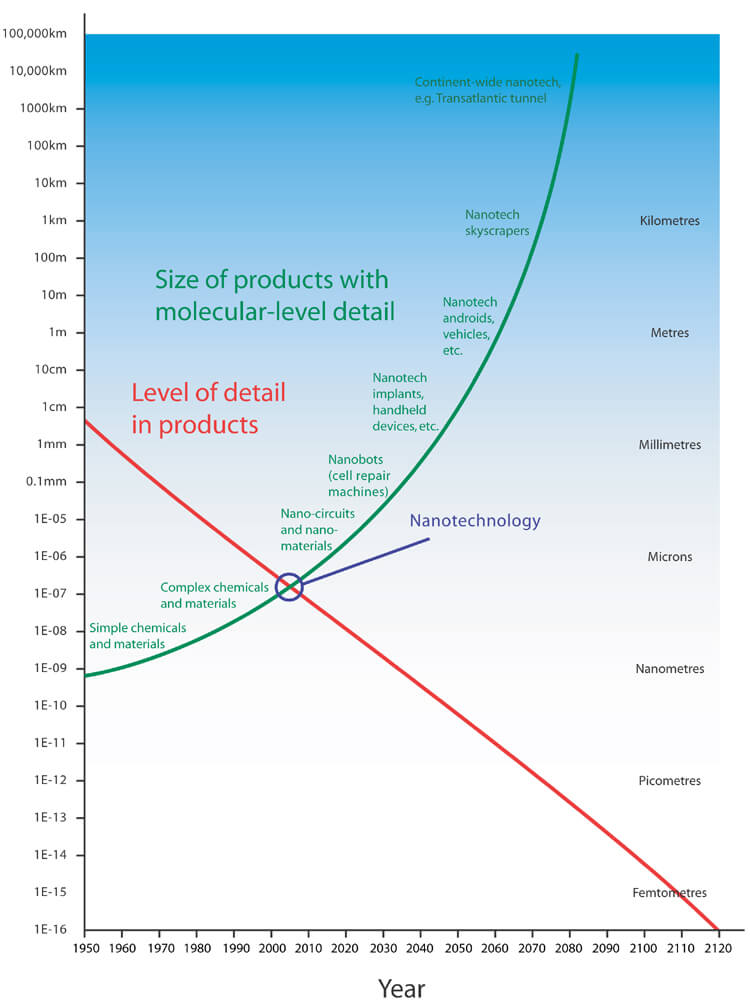
Invisibility suits are in military use
Once considered purely theoretical, advances in metamaterials have enabled the creation of truly invisible camouflage suits.* When activated, these render the wearer completely transparent.
Once considered purely theoretical, advances in metamaterials have enabled the creation of truly invisible camouflage suits.* When activated, these render the wearer completely transparent.
Breakthroughs in earlier decades showed that objects utilising metamaterials could be made invisible to microwave radiation. This was followed some years later by infrared radiation, until eventually all the frequencies of visible light on the spectrum could be filtered. When combined with advances in nanotech, this made it possible to produce lightweight fabrics that could bend light in three dimensions.
A complex "mosaic" of nano-implants is embedded into the suit. These mosaics are stacked in layers: one for each frequency of the visible light spectrum. The effect is similar to that of a river flowing around a boulder. Light flows around the suit, before continuing in a straight line towards the onlooker.
The layers are so thin, and the implants so small, that the fabrics offer the wearer complete freedom of movement and flexibility. These suits are expensive, however, and are used mainly by special forces in covert operations.
The only obvious vulnerability is when the suits are used in heavy rain, or if crossing a body of water.
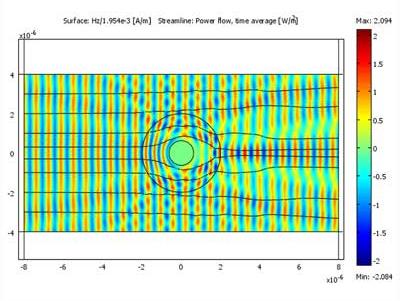
Cloaking device active: Light is deflected around the object, causing it to be invisible.
Credit: Birck Nanotechnology Center, Purdue University
Credit: Birck Nanotechnology Center, Purdue University
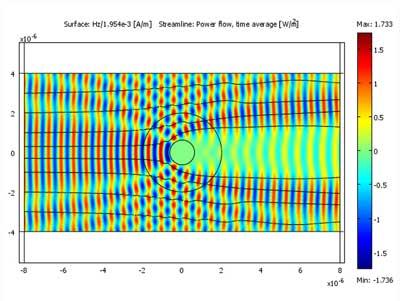
Cloaking device deactivated: Light is reflected and absorbed, causing it to be visible.
Credit: Birck Nanotechnology Center, Purdue University
Credit: Birck Nanotechnology Center, Purdue University
Insurance crisis
Damage wrought by accelerating climate change has led to many insurance firms filing for bankruptcy. In America, widespread flooding has resulted in hundreds of billions of dollars' worth of damage. Coastal cities are particularly badly hit. Much of the infrastructure in the southern states has been destroyed by category 5 hurricanes, with Houston and New Orleans virtually abandoned.
Damage wrought by accelerating climate change has led to many insurance firms filing for bankruptcy. In America, widespread flooding has resulted in hundreds of billions of dollars' worth of damage. Coastal cities are particularly badly hit. Much of the infrastructure in the southern states has been destroyed by category 5 hurricanes, with Houston and New Orleans virtually abandoned.
Along the west coast, gigantic forest fires spread by the tinder-dry ground have ravaged much of the land. There are chronic water shortages. The economy of California is in tatters.
Some of the biggest insurance firms are nationalised by the US government in a bid to avert economic collapse.
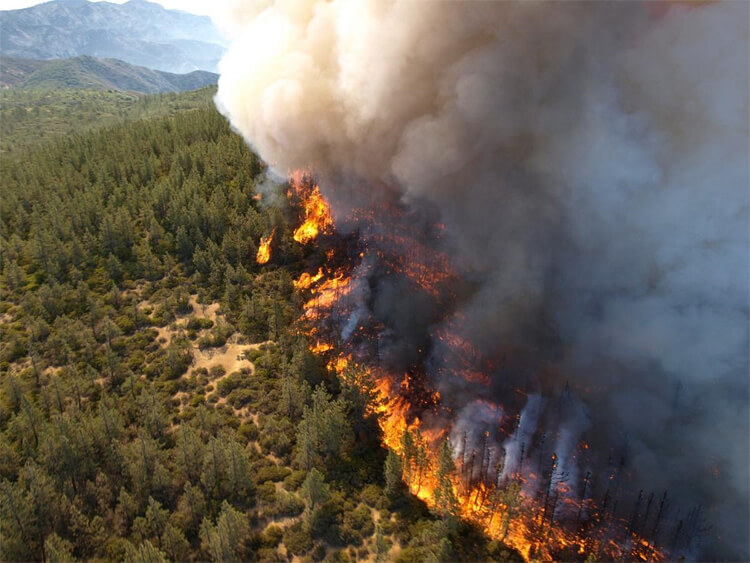
2067
Male and female salaries are reaching parity
By this date, the gender gap has narrowed to such an extent that salaries and rights are pretty much equal for both sexes (in the Western world, at least).
By this date, the gender gap has narrowed to such an extent that salaries and rights are pretty much equal for both sexes (in the Western world, at least).
Women are now playing a greater role in business and government than ever before. Just one consequence has been a significant reduction in military spending compared to circa 2000 levels. The money and resources saved are being diverted to education, healthcare, transport and environmental programmes, improving the living standards and opportunities for many. With less male aggression in world affairs, more balanced and rational discourse is taking place on many international issues. The world of capitalism, too, is undergoing some of its biggest changes in almost a century, with less pursuit of short term "profit at all costs" and a much greater emphasis on long term stability.
Other factors have been responsible for this shift in focus - such as the terrifying depletion of natural resources, which has forced a radical change of priorities. Widespread use of AI in neutral, passive, consultative roles is also helping to strengthen cooperation by providing more "logical" solutions to global problems.
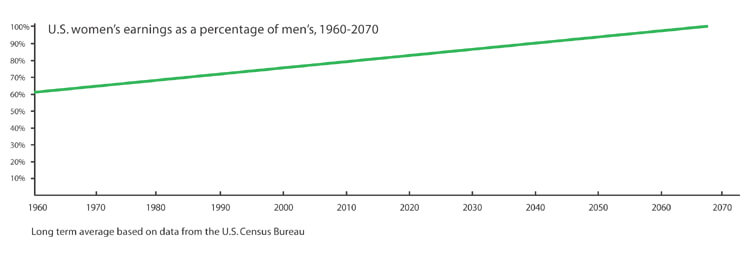
2068
A major landmark in the world of athletics*
At the 2068 Olympics, a major landmark is passed when a black male athlete completes the 100m sprint in less than nine seconds. Improved lifestyles and training techniques - including use of VR for mental enhancement - has seen the world record continue to fall during the last few decades. However, these records will soon be hitting a barrier as it becomes physically impossible for humans to run any faster without the use of biotechnological aids.*
At the 2068 Olympics, a major landmark is passed when a black male athlete completes the 100m sprint in less than nine seconds. Improved lifestyles and training techniques - including use of VR for mental enhancement - has seen the world record continue to fall during the last few decades. However, these records will soon be hitting a barrier as it becomes physically impossible for humans to run any faster without the use of biotechnological aids.*
A new breed of "super athlete" emerges, as the authorities begin to legalise certain implants, drugs and muscle-enhancing devices. There is talk of splitting the games into three separate events - the Paralympics for those with disabilities; a "classic" group for natural, unenhanced athletes; and a third "cyber" category for those with biotechnology enhancements.
The Paralympics will eventually disappear altogether as literally all physical and visual disabilities are overcome.
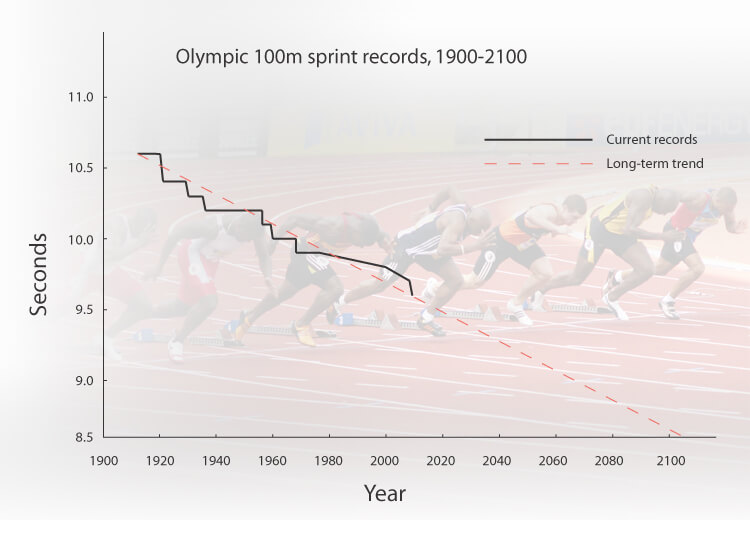
2069
100th anniversary of Apollo 11
Exactly one century has passed since Neil Armstrong made the first historic landing on the Moon. The anniversary is marked by celebrations in the lunar colonies. It later becomes the first off-Earth national holiday.
Exactly one century has passed since Neil Armstrong made the first historic landing on the Moon. The anniversary is marked by celebrations in the lunar colonies. It later becomes the first off-Earth national holiday.
By this date, the Apollo 11 landing site has been turned into a UNESCO world heritage site and tourist destination. Visitors can walk around the lunar module and see the famous flag and footprints left by the astronauts. With no atmospheric conditions, these have been perfectly preserved - exactly as they were on the day.*
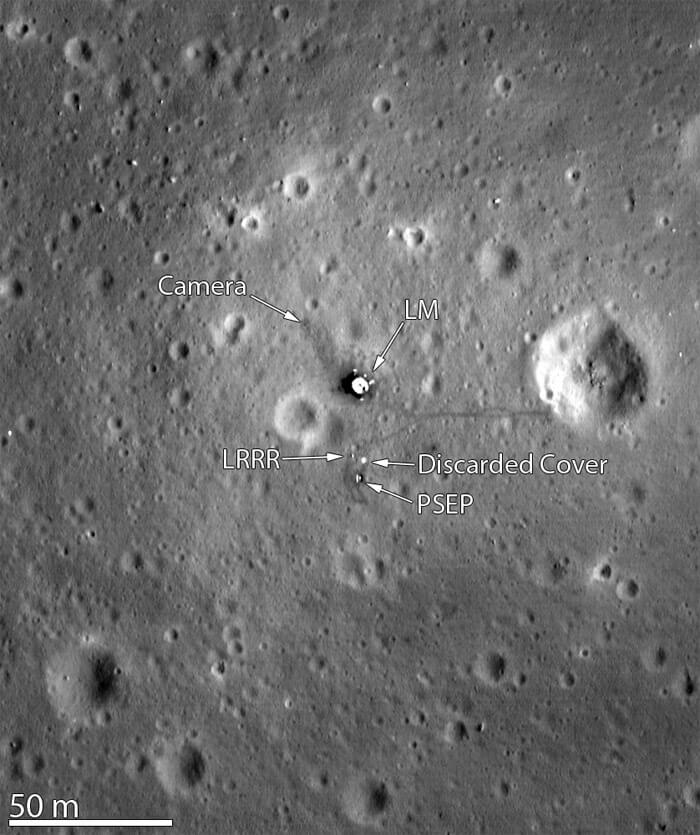 Credit: NASA
Credit: NASA
2070-2079 Contents
2070
Fusion power is widespread
Every leading country now has at least one fusion power plant either operational, or in the process of construction. These reactors offer a clean, safe, abundant supply of energy - but have come too late to prevent climate change.
Every leading country now has at least one fusion power plant either operational, or in the process of construction. These reactors offer a clean, safe, abundant supply of energy - but have come too late to prevent climate change.
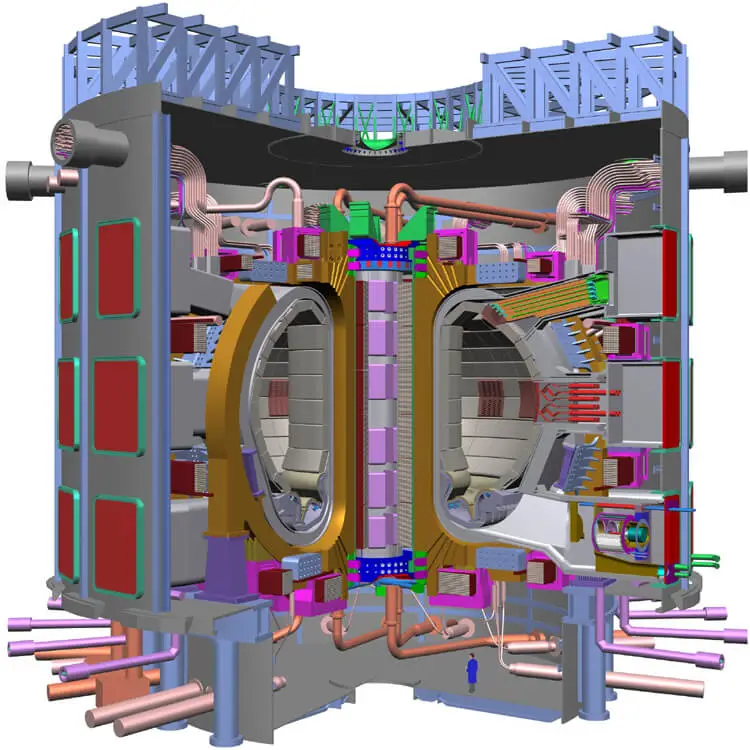
Fully automated homes
Buildings everywhere are becoming highly automated, self-sufficient and organised. In addition to robots, a typical new build home now includes the following:
Buildings everywhere are becoming highly automated, self-sufficient and organised. In addition to robots, a typical new build home now includes the following:
A localised power supply. Energy can be generated by the building itself, via a combination of photovoltaics and piezoelectric materials. Walls, roofs and windows can absorb almost all wavelengths of light from the Sun with organic solar technology, turning it into heat and electricity. Friction generated by the occupant's footsteps - and various other kinetic processes - can also produce energy. This is converted and stored in any number of ways, from hydrogen to batteries. In countries where sunlight is less frequent, microturbines may be used in place of solar.
On-site water production and waste management. Rain is captured by external guttering, then stored and converted into drinking water using nanofiltration systems. This is especially useful in regions prone to drought (which includes a substantial portion of the world by this time). If local water is in short supply, houses can serve as miniature reservoirs and filtration systems. Meanwhile, plastics and other kitchen waste can be placed in recycling machines, ground into extremely fine powder, then later re-used in nanofabricators.
A multi-layered building envelope which provides a variety of dynamic effects. Windows can self-adjust their size and position - as well as their opacity - to optimise the level of natural light. In some of the more upmarket properties, the entire façade can morph its texture and appearance through the use of claytronics. Depending on the tastes of the occupant, this could transform into an art deco style, a classic Victorian building, or something entirely different. This form of "programmable matter" can even be designed by the occupant themselves and changed on demand.
Air purification systems. Air within the home is kept fresh, purified and completely free of dust and microbes.
Interactive surfaces. Holographic generators cover the whole interior of the property – including walls, doors, worktop surfaces, mirrors and shower cubicles. These intelligent surfaces can track the position of the occupant and display information whenever and wherever necessary. A person can read emails, see news reports and access the online world using virtually any surface in the house as a touch screen or mind control interface.* Detailed, real-time information on their health, personal lifestyle and daily schedules can also be displayed. This system has a variety of other functions, e.g. it can be used to locate personal items which may have been misplaced.
Intelligent/self-maintaining appliances. Appliances that don't repair or maintain themselves in some way have become largely obsolete by now. It is very rare for a human engineer to be called to the house.
A modest size. The world is becoming an ever more crowded place, with available land continuing to shrink due to overpopulation and environmental decline. In city centres, apartments tend to be highly minimalist and compact, with small footprints and interiors utilising every inch of space. Full immersion virtual reality is one method of adapting to this situation. However, another is with "flexible" room layouts that reconfigure themselves on demand. In earlier decades, this was achieved manually, using a sliding wall system.* Today, it can be done remotely and automatically - using morphable claytronics.
Expansion of Moon bases
Building on the success of the Helium-3 extraction programmes, a whole series of bases are appearing on the Moon. Other resources are now being mined including precious metals and minerals - resources which are becoming increasingly rare on Earth.
Building on the success of the Helium-3 extraction programmes, a whole series of bases are appearing on the Moon. Other resources are now being mined including precious metals and minerals - resources which are becoming increasingly rare on Earth.
Perhaps more importantly, this is being combined with on-site processing and production, to build new structures and facilities around the original bases. Solar panels, tools and other equipment, for example, can be manufactured without needing to be delivered from Earth, whilst entire new buildings can be created with the help of robots and self-assembling nanofabricators. Paths can be carved out from the lunar regolith, with functional roads built on them using materials extracted nearby.
Meanwhile, small hydroponic farms - carefully controlled and maintained - are providing a continuous supply of food and water to the astronauts.
All of this is producing the critical mass needed for a thriving, self-sustaining presence on the Moon. A few decades from now, it will be open for civilian settlement.
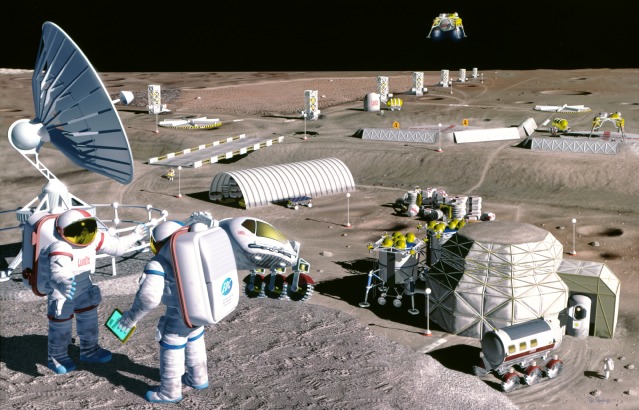
Credit: NASA
2072
Picotechnology is becoming practical
Technology on the scale of trillionths of a metre (10-12) is becoming practical around this time.* This is orders of magnitude smaller than the nanotech of previous decades.* In the coming years, one significant development to come from this will be the Heisenberg compensators used in teleportation.
Technology on the scale of trillionths of a metre (10-12) is becoming practical around this time.* This is orders of magnitude smaller than the nanotech of previous decades.* In the coming years, one significant development to come from this will be the Heisenberg compensators used in teleportation.
2074
The Green Wall of China is completed
A 73-year environmental project - to halt the advancing sands of the Gobi Desert - is finally completed this year.*Beijing and other cities along China's northeastern border are now protected from desertification by a 4,500 km barrier of newly planted trees.* This becomes the largest single ecological project of the century.
To build it, the government established a plan involving three approaches. Firstly, aerial seeding over vast swathes of land where the soil was less arid. Secondly, the paying of farmers to plant trees and shrubs in areas requiring greater attention. Thirdly, the construction of a huge fence along the perimeter.
Inside this gigantic new forest, sand-tolerant vegetation was arranged in optimised checkerboard patterns to create an artificial ecosystem that stabilised the dunes. A gravel platform held sand down and encouraged the formation of a soil crust. The government also funded research into genetically engineered plants, chemical dune stabilisation, grass strains bred in space, and even farming techniques that allowed rice to grow in sandy soil.
Prior to the Wall's erection, the Gobi had been advancing south at 3 km per year.
2075
The ozone layer has fully recovered
Chlorofluorocarbons (CFCs) were invented in the 1920s. They were used in air conditioning/cooling units, as aerosol spray propellants prior to the 1980s, and in the cleaning processes of electronic equipment. They also occured as by-products of some chemical processes.
No significant natural sources were ever identified for these compounds - their presence in the atmosphere was found to be almost entirely due to human activity. When such ozone-depleting chemicals reached the stratosphere, they dissociated by ultraviolet light to release chlorine atoms. The chlorine atoms acted as a catalyst, each one breaking down tens of thousands of ozone molecules before being removed from the stratosphere.
The ozone layer prevents most UV wavelengths of sunlight from passing through the Earth's atmosphere. In the late 20th century, huge decreases in ozone generated worldwide concern. It was suspected that a variety of biological consequences - such as increases in skin cancer, cataracts, damage to plants, and reduced plankton populations - resulted from the higher levels of UV exposure due to ozone depletion.
This led to the adoption of the Montreal Protocol - one of the single most successful international agreements of all time, which banned the production of CFCs, halons and related ozone-depleting chemicals. Although this ban came into force in 1989, the molecules had a longevity of several decades. In 2006, the ozone hole was the largest ever recorded, at 10.6 million square miles (pictured below). It was not until 2075 that it fully recovered.*
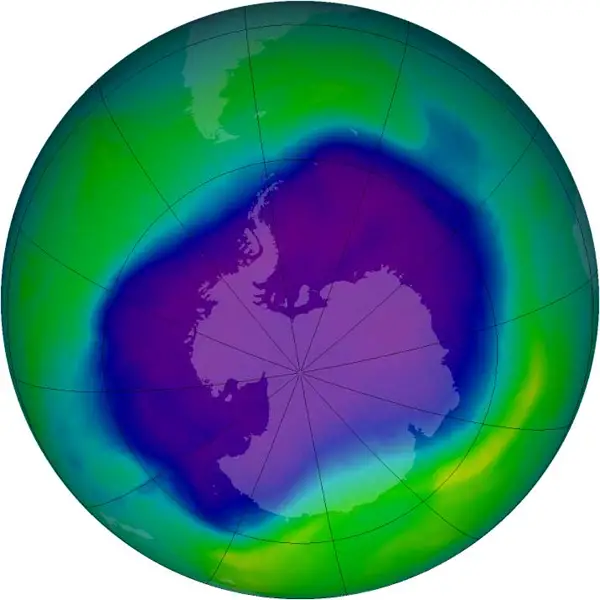
Credit: NASA
London and other major cities are being flooded
Following a series of floods - triggered by a combination of rising sea levels and freak weather - the Thames Barrier in London has been replaced by a larger successor.*
The original barrier was raised a total of 62 times between 1983 and 2001. It was raised with increasing frequency as the decades went by. Towards the end of this century, its successor may have to be raised over 200 timesevery single year to cope with the combined impact of stronger storms and sea level rise.*
2076
Unmanned probes to Sedna
Sedna is a trans-Neptunian "dwarf planet", similar in size and composition to Pluto.* Discovered in 2003, it became the most distant object yet observed in the solar system, and the largest solar body to be found in over 70 years.
Sedna is a trans-Neptunian "dwarf planet", similar in size and composition to Pluto.* Discovered in 2003, it became the most distant object yet observed in the solar system, and the largest solar body to be found in over 70 years.
Its orbit is highly elliptical - taking it from 76 AU to about 975 AU over the course of 12,000 years.
In 2076, it reaches perihelion (its closest point to the Sun) and a series of unmanned probes are sent to explore it.
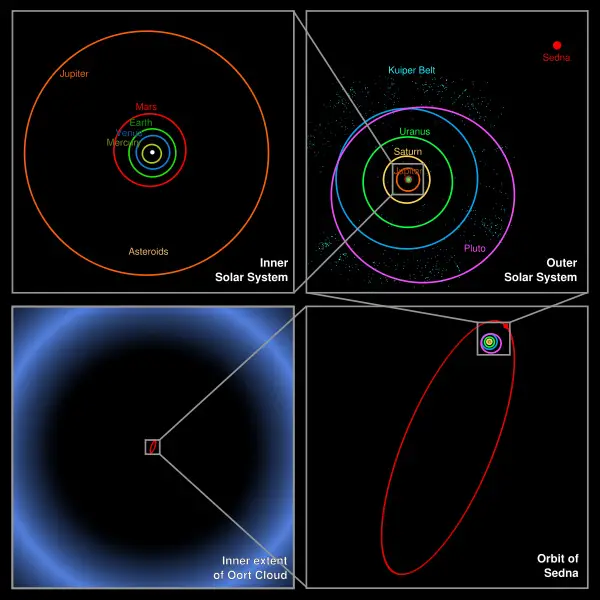
Credit: NASA
2079
Practical flying cars are entering the consumer market
Anti-gravity propulsion has been under development for almost a century now.* Initially seen in military applications, it eventually found its way to the consumer market. Here, it began showing up in various luxury items and devices, such as hoverboards and floating recliners.
Anti-gravity propulsion has been under development for almost a century now.* Initially seen in military applications, it eventually found its way to the consumer market. Here, it began showing up in various luxury items and devices, such as hoverboards and floating recliners.
Further refinement of this technology - together with advances in AI, microjets and collision avoidance systems - has led to the dawn of a new era in personal transportation. In the late 2070s, it is not uncommon to see what citizens of earlier decades might describe as "flying cars" moving through cities.
In fact, these are light-duty vehicles based on earlier military VTOL (Vertical Take-Off and Landing) craft, but with slimmed down functionality and costs. They come in a variety of models and sizes, but are typically around 4 metres wide, and limited to a maximum of one or two passengers. By the end of this decade, they are becoming cheap, safe and numerous enough to be regarded as a mainstream form of transport.
The craft have a number of advantages over established forms of mobility. Since they float above the ground, they can access terrain and environments that would easily defeat traditional automobiles. This makes them popular with adventurers and explorers. They are also substantially faster than normal cars, able to reach several hundred kilometres per hour if necessary. They are more versatile and manoeuvrable than aeroplanes and can utilise a much greater volume of airspace. Since the traffic they generate is decentralised and there is so much available airspace, this makes them safer than both cars and aeroplanes, too. Collisions are almost unheard of, in any case, due to the onboard software and AI.
In addition, they use considerably less fuel than earlier forms of transport and require less maintenance.
Some of the more expensive models are capable of reaching low Earth orbit for short periods. Others feature striking designs, often personalised by their owner - such as holographic decals and other accessories. These craft are being used by many businesses too (especially for rapid delivery of goods), as well as police and ambulance crews.
Further developments in anti-gravity will lead to bigger, more sophisticated versions - including recreational vehicles serving as truly mobile homes. Many previously inaccessible parts of Earth will become inhabited thanks to this, such as mountains and remote islands.
2080-2089 Contents
2080
Some humans are becoming more non-biological than biological
Today, the average citizen has access to a wide array of biotechnology implants and personal medical devices. These include fully artificial organs that never fail, bionic eyes and ears providing Superman-like senses, nanoscale brain interfaces which greatly augment the wearer's intelligence, synthetic blood and bodily fluids which can filter deadly toxins and provide hours' worth of oxygen in a single breath.
Some of the more adventurous citizens are undergoing voluntary amputations to gain prosthetic arms and legs which boost strength and agility by orders of magnitude. There is even a form of artificial skin based on nanotechnology (which can be used to give the appearance of natural skin when applied to metallic limbs).
These various upgrades have become available in a series of gradual, incremental steps over preceding decades - such that today, they are pretty much taken for granted.
They are now being utilised by a wide sector of society, with even those in developing countries having access to at least some of the available upgrades due to exponential trends in price performance.
If a fully upgraded person of the 2080s were to travel back in time a century earlier and be integrated into the population, they would be superior in practically every way imaginable. They could run faster than the greatest athletes of the time; they could leap and bound tremendous distances; they could survive multiple gunshot wounds; they could cope with some of the most hostile environments on Earth without too much trouble. Intellectually, they would put the likes of Albert Einstein and William Shakespeare to shame – thanks to the hyperfast AI merged directly with their brain.
Construction of a transatlantic tunnel
Built from advanced automation and robots - and controlled largely by AI - this is among the largest, most ambitious engineering projects ever undertaken. With hyperfast Maglev up to 4,000mph, passengers using the tunnel can be delivered from Europe to America in under an hour.
Built from advanced automation and robots - and controlled largely by AI - this is among the largest, most ambitious engineering projects ever undertaken. With hyperfast Maglev up to 4,000mph, passengers using the tunnel can be delivered from Europe to America in under an hour.
Carbon nanotubes, along with powerful geo-sensing devices, have been paramount in the structure's design - these can self-adjust in the event of undersea earthquakes, for example. Also noteworthy is that the trains operate in a complete vacuum. This eliminates air friction and allows the hypersonic speeds to be reached.
The cost of this project is in the region of $88-175bn,* which has been funded by various international agreements.
Vast numbers of climate refugees are making use of this tunnel.
Polar bears face extinction
Between 2000 and 2050, polar bear numbers dropped by 70 percent, due to the shrinking of ice sheets caused by global warming. By 2080, they have disappeared from Greenland entirely - and from the northern Canadian coast - leaving only dwindling numbers in the interior Arctic archipelago.*
Of the few which remain, ice breaking up earlier in the year means they are forced ashore before they have time to build up sufficient fat stores. Others are forced to swim huge distances, which exhausts them, leading to drowning. The effects of global warming have led to thinner, stressed bears, decreased reproduction, and lower juvenile survival rates.
One in five lizard species are extinct
The ongoing mass extinction is beginning to claim many exotic and well-known lizards. One in five species are now extinct as a result of global warming. Lizards are forced to spend more and more time resting and regulating their body temperature, which leaves them unable to spend sufficient time foraging for food.*

Deadly heatwaves plague Europe; traditional agriculture is decimated
Heatwaves greater than that seen in 2003 have become annual occurrences by this time.*
In the peak of summer, temperatures in major cities such as London and Paris reach over 40°C. In some of the more southerly parts of the continent, temperatures of over 50°C are reported. Thousands are dying of heat exhaustion.
Forest fires rage in many places* while prolonged, ongoing droughts are causing many rivers to run permanently dry. Spain, Italy and the Balkans are turning into desert nations, with climates similar to North Africa.
This period effectively marks the end of traditional agriculture for many EU countries, and sees the establishment of whole new farming systems based on carefully controlled indoor environments. In the short term, this causes tremendous social and economic disruption, but in the longer term is conducive to the betterment of humanity.
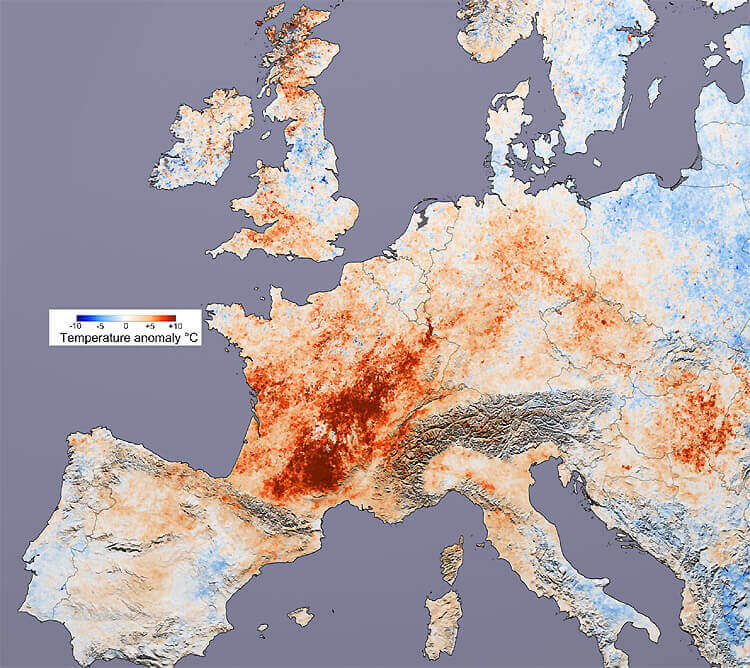
Credit: NASA
2082
The USA cedes territory to Mexico
For over two centuries, the United States effectively controlled the entire North American continent. Its dominance throughout this time was unquestioned.
For over two centuries, the United States effectively controlled the entire North American continent. Its dominance throughout this time was unquestioned.
During the late 21st century, however, its territorial integrity was being challenged once again. By the early 2080s, four of its fifty states had been ceded to Mexico.*
What led to this astonishing development?

Most historians would agree it began in the 2030s. America's shrinking labour supply during this time led to the introduction of laws encouraging a massive influx of immigrants. These came from all over the world - but a substantial portion came from Mexico due to its geographical proximity and strong cultural ties. Although many different ethnic groups would arrive, the Mexicans would behave differently. It was this, combined with Mexico's growing economic strength, that would lead to a slow but gradual shift in the balance of North American power.*
The various immigrant groups from around the world became culturally integrated with the USA. They fragmented and settled around the country, without overwhelming any region or state.
The immigrants from Mexico behaved differently, however. Many became integrated with the USA - but unlike the other groups, they would always be in close proximity to their homelands. With most settling in California, Arizona, Texas and New Mexico, they were never more than a short journey from the border. This fostered a growing intermingling of cultures in the southwestern states.
Over time, the social and economic links of the Mexican immigrants began to predominate, to such an extent that they almost represented an extension of their homeland into the United States. These lands had once been Mexican anyway - before the territory was taken by the US in the 19th century - so they already held many characteristics of Mexican society and culture. As the decades rolled by, with more and more immigrants pouring into the country, this influence shifted ever northward. By the middle of the century, states that had been 25% Mexican were now over 50% Mexican, while states which had been 50% Mexican were now almost entirely occupied by Mexicans.*
Climate change was now an added factor, driving large numbers from the southern parts of Mexico to head north, where food and water was more readily available.
This wave of immigration solved the labour supply issue, and contributed to a period of economic boom in the USA.
At the same time, however, a number of radical new technologies were in development: technologies that would lead to a socio-political crisis in later years. Chief amongst these was the growth of robotics. A range of highly versatile machines had already been in military use since the 2030s. These began spreading to consumer markets. By the 2060s, they were becoming sufficiently powerful, intelligent and numerous to make vast numbers of civilian jobs redundant.
This greatly reduced the need for immigration. Millions of workers were now permanently displaced, without the skills to move into robotics support or maintenance. Their previous roles were now being handled by machines that were not only cheaper, but also faster and more productive than any human. Manufacturing, mining, building and construction trades, mechanical work, maintenance and a host of other roles were being dominated by robots.
Unemployment began to soar, exacerbated by advances in longevity which meant that workers were now remaining active longer than ever before. This combination of increased labour pool and redundant workers meant that immigration into America had become a problem rather than a solution.
The US government began limiting its intake of immigrants and addressing the economic imbalance. This would prove disastrous for the poor and working class, however: especially those in the borderlands.
By the 2070s, Mexico was emerging as a major regional power. It now had a balanced and mature economy ranked eighth in the world, along with a stable population, a relatively high standard of living, and growing military power. Mexican nationalism had already been on the rise. Combined with the turmoil now unfolding in the southwestern USA (including the forced repatriation of many immigrants), this began spilling into outright anti-Americanism.
Tensions continued to grow. A critical mass had been reached, with most of the immigrants regarding themselves as a separate entity within the USA - linked to and part of Mexico itself, but under foreign domination. An annexation movement began to arise. Army troops on both sides began to mobilise and patrol the border. American citizens viewed the radicalisation of the south with increasing fear.
Long, drawn-out political battles ensued between Washington and Mexico City. Both sides made it clear that neither desired war. It also became clear that the Mexican president - in effect - was negotiating on behalf of American citizens of Mexican origin within the United States. The recognition of a distinct nation living within the USA appeared inevitable, with no chance of a return to the status quo.
By the early 2080s, following years of negotiations, the matter was finally settled. The country of Mexico had been expanded to include California, Arizona, New Mexico and Texas: effectively reclaiming its 19th century territory.
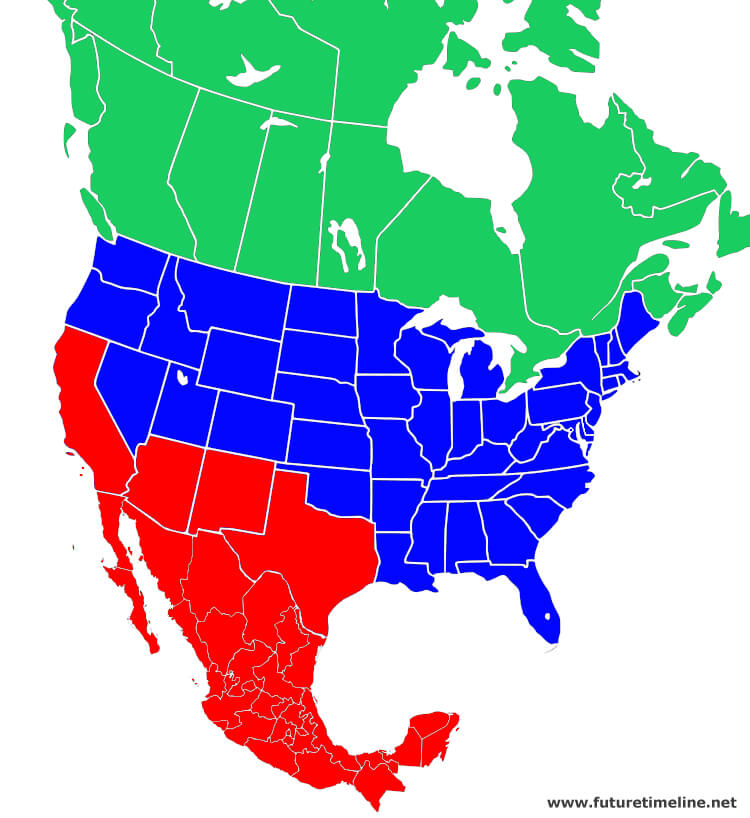
Above: The territorial status of Mexico and the USA, 2082.
2083
Hyper-intelligent computers
Due to Moore's Law, $1000 of computing power is now equivalent to a billion Earth's worth of human brains.*
Due to Moore's Law, $1000 of computing power is now equivalent to a billion Earth's worth of human brains.*
A laptop-sized computer of today can perform the equivalent of all human thought over the last ten thousand years in less than ten microseconds.
Technology is progressing so fast that - in order for people to comprehend it - neural upgrades are becoming necessary on a regular basis.

Credit: Ray Kurzweil
2084
Androids are entering law enforcement
Fully autonomous mobile robots with human-like features and expressions are being deployed in many cities now.*These androids are highly intelligent - able to operate in almost any environment and dealing with a range of duties. In addition to their powerful sensory and communication abilities, they have access to bank accounts, tax, travel, shopping and criminal records, allowing them to instantly identify people on the street.
Fully autonomous mobile robots with human-like features and expressions are being deployed in many cities now.*These androids are highly intelligent - able to operate in almost any environment and dealing with a range of duties. In addition to their powerful sensory and communication abilities, they have access to bank accounts, tax, travel, shopping and criminal records, allowing them to instantly identify people on the street.
The presence of these machines is freeing-up a tremendous amount of time for human police officers.
They are also being used in crowd control and riot situations. With their superhuman strength and speed, a single android is highly intimidating and can easily take on dozens of people if necessary. Special controls are featured in their programming, however, to prevent the use of excessive force.*
2085
Global currency
By now, the vast majority of countries have adopted a single, global currency. The USA is among the last developed nations to do so.
By now, the vast majority of countries have adopted a single, global currency. The USA is among the last developed nations to do so.
International business is now fairer, more efficient and more stable. Problems with inflation which had plagued some economies in the past are eliminated. The poor are no longer being hurt by the impacts of currency fluctuations.
All but the most impoverished societies are now cashless. For the typical citizen of today, transactions take place without any need for physical coinage, notes or even cards, instead being achieved by on-person nanotechnology.
A substantial portion of the world's GDP now comes from goods and services produced entirely online, often within highly sophisticated virtual environments. Full immersion VR is impacting on real world commerce, as more and more people become willing to utilise the necessary bio-implants.
Many people today invest more time and money in their virtual home than they do in their actual, physical home. This is especially true of those living in China, India and Japan - where cities are so dense, overcrowded and expensive that many residents are forced to live in pod-like structures, cubicles or shared rooms. The online world offers a welcome escape from this stressful way of life. Indistinguishable from reality, a person's virtual home can appear as a gigantic mansion, in exotic and beautiful surroundings, decorated in whatever style the occupant desires, with many luxurious items of furniture. Being entirely digital, these can be bought for a fraction of the cost of their real world counterparts.
Macro-scale teleportation is achieved
Recent experiments in quantum entanglement - made possible by AI and picotechnology - have yielded major breakthroughs. It is now possible to teleport macro-scale objects from one location to another. The objects being tested are still very small (e.g. grains of sand), but are nevertheless visible to the naked eye, and retain their original structure following the procedure.*
Recent experiments in quantum entanglement - made possible by AI and picotechnology - have yielded major breakthroughs. It is now possible to teleport macro-scale objects from one location to another. The objects being tested are still very small (e.g. grains of sand), but are nevertheless visible to the naked eye, and retain their original structure following the procedure.*
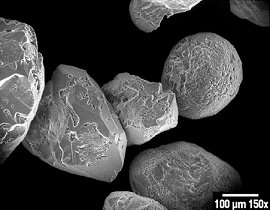
Credit: NASA
2085-2089
Manned exploration of the Jovian system
Solar sail technology, nuclear pulse propulsion and other forms of rapid space travel have seen major advances in recent decades.* Together with greatly reduced launch costs and improved access to low-Earth orbit, this is making it financially and technically feasible to conduct manned exploration of Jupiter.
Solar sail technology, nuclear pulse propulsion and other forms of rapid space travel have seen major advances in recent decades.* Together with greatly reduced launch costs and improved access to low-Earth orbit, this is making it financially and technically feasible to conduct manned exploration of Jupiter.
At least one expedition to the gas giant has been attempted by now. This is a privately funded venture, with only a small number of crew onboard, and succeeds in rendezvousing with a moon of Jupiter* in addition to orbitting the planet itself.
2090-2099 Contents
2090
Religion is fading from European culture
In some European nations, the number of people considering themselves to be non-religious has increased from around 30% in 1980, to over 90% now.*
Although large numbers of Muslims populate the continent, a substantial portion are now only "culturally" Muslim, rather than having a literal interpretation of the Koran. Mainstream Islam has begun a reformation and modernisation in recent years - aided by vast improvements in education, combined with the broad homogenisation of culture resulting from globalisation, the Internet, various international agreements and other factors.
Medical advances are undermining religion as a whole, by greatly diminishing the fear of death, while developments in AI, robotics and biotechnology are beginning to trivialise the miracles on which many ancient religions are based. The increasing presence of androids in society - along with other forms of sentience - is adding a whole new dimension to the way humans view themselves and their place in the Universe. The ability to communicate with certain artifically enhanced animals (such as dolphins, monkeys and domestic pets) is also contributing to this trend.
Spirituality continues to play a role in European cultures - but is now based more on nature and physical reality, rather than myths, dogma or supernatural forces.
The USA still lags far behind Europe in terms of atheistic belief, however. It will be another century before America reaches the same level; even longer for certain parts of Asia. Even then, a small percentage of citizens will continue to worship a God (or Gods), well into the next millenium. These people will tend to be those who reject science and technology, or have purposefully chosen to isolate themselves from the rest of the world.
Click to enlarge.
2092
West Antarctica is among the fastest growing areas in the world
The icy continent today would be unrecognisable to observers from the 20th century. Its northern peninsula is now home to a multitude of towns and conurbations, with a total population numbering in the millions.
Melting of surface ice has resulted in conditions appropriate for large-scale human settlement.* Even farming and crop growing is now possible in some of the most northerly areas. Air temperatures in the polar regions have increased more than anywhere else in the world - meaning that parts of Antarctica are now comparable with the climates of Alaska, Iceland and northern Scandinavia.
Huge levels of immigration are now underway from countries all over the world that have been affected by climate change, creating a diverse mixture of people and cultures flocking to this new land of opportunity. In some ways, the settlement of Antarctica is similar to that of America in the 18th and 19th centuries. The highest density cities are becoming cultural "melting pots" similar to New York and London.
The world is rapidly moving towards a situation where certain equatorial regions have been abandoned altogether. Enormous deserts now cover Africa, southern Asia, Central America, parts of the southern USA and even southern European states.*
2095
Many of the world's languages are no longer in use
The accelerating pace of globalisation has seen the number of human languages decline from around 7,000 in the late 20th century, to less than a quarter of this now.*
The accelerating pace of globalisation has seen the number of human languages decline from around 7,000 in the late 20th century, to less than a quarter of this now.*
Many old sayings, customs and traditions are being abandoned or forgotten, as the world becomes an ever smaller and more interconnected place. Changing social and economic conditions have forced many parents to teach their children the lingua franca, rather than obscure local dialects, in order to give them a better future. This is especially true in Africa and Asia.
This broad homogenisation of culture has been further propagated by the stunning advances in technology which have swept the world. Many people in developed countries, for instance, are abandoning their native tongues altogether, instead relying on mind control interfaces for their everyday communications. The young especially are utilising this form of digital telepathy. Most teenagers in the 2090s spend almost their whole time interacting via electronic devices, rather than verbally speaking. The latter can be almost an inconvenience in some situations due to the longer time intervals in conversations.
Meanwhile, many tribes people and isolated communities have lost their homelands due to war, climate change, deforestation and changing land uses. This forced migration and assimilation into the wider world has led to many ancient and rural languages dying out.
English, Mandarin and Spanish remain the lingua franca of international business, science, technology and aviation.*
Manned exploration of the Saturnian system
The success of the Jupiter missions proved that long range, manned exploration of the solar system was possible. Several further missions are now underway, including the first trip to Saturn - this time using pulsed fusion drives. These allow spacecraft to travel billions of miles in a matter of weeks.
The success of the Jupiter missions proved that long range, manned exploration of the solar system was possible. Several further missions are now underway, including the first trip to Saturn - this time using pulsed fusion drives. These allow spacecraft to travel billions of miles in a matter of weeks.
In addition to orbiting the planet itself, the astronauts conduct close-range observation of its moons and rings. Robots are dispatched to the surface of Titan, with samples being taken of its atmosphere and oceans.
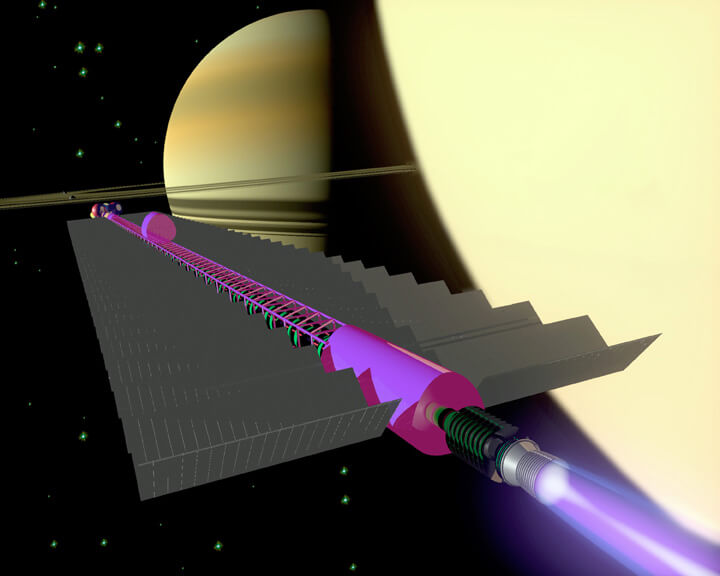
Credit: NASA
2099
Sea levels are wreaking havoc around the world
Despite efforts to halt climate change, it came too late to save many lowland areas of the world. Sea levels rose nearly two metres by the end of the 21st century, displacing hundreds of millions of people.* The Maldives were especially hard hit, with most of the nation disappearing underwater completely.*
Despite efforts to halt climate change, it came too late to save many lowland areas of the world. Sea levels rose nearly two metres by the end of the 21st century, displacing hundreds of millions of people.* The Maldives were especially hard hit, with most of the nation disappearing underwater completely.*
Nations around the globe were forced to begin large-scale evacuation and resettlement programmes, while trillions of dollars were spent on coastal defences.
Over 80% of the Amazon rainforest has been lost
Due to the combined impacts of logging, drought, forest fires, desertification, agriculture and industrial expansion, less than one-fifth of the Amazon now remains.*
Due to the combined impacts of logging, drought, forest fires, desertification, agriculture and industrial expansion, less than one-fifth of the Amazon now remains.*
In addition to mass extinctions of flora and fauna, indigenous peoples' communities are now rapidly vanishing.
Positive feedback loops - caused by elevated atmospheric CO2 - mean there is now essentially no hope of saving the rainforest. A tipping point has been passed, setting the stage for its irreversible decline.*
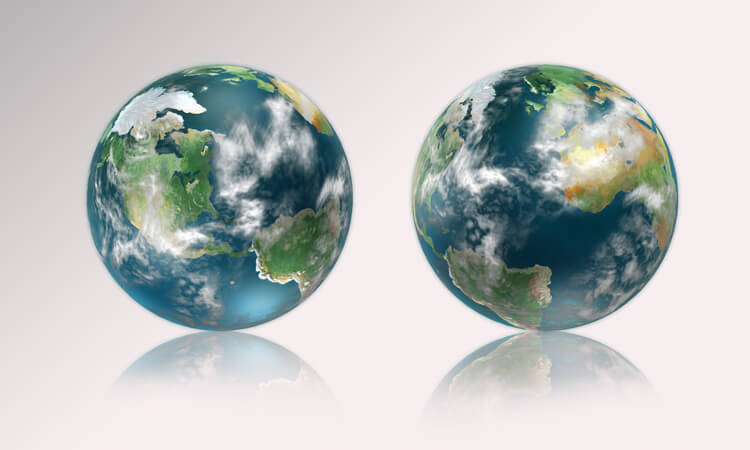


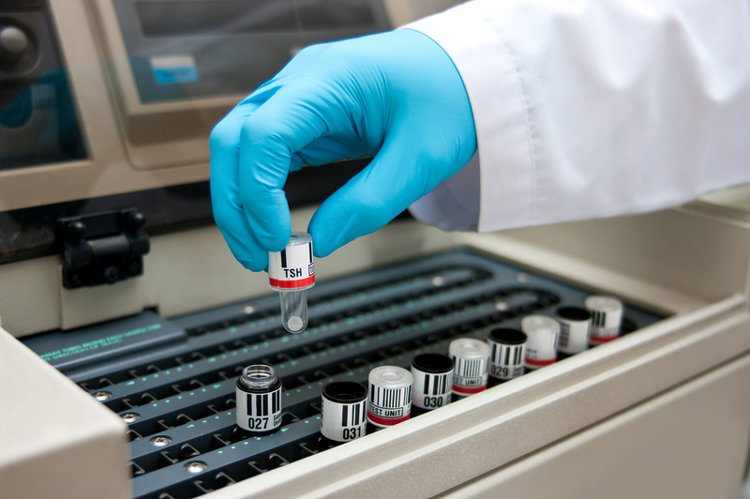
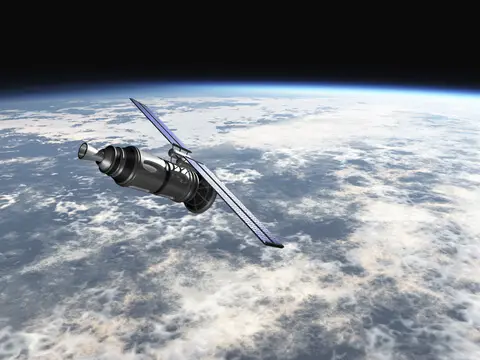
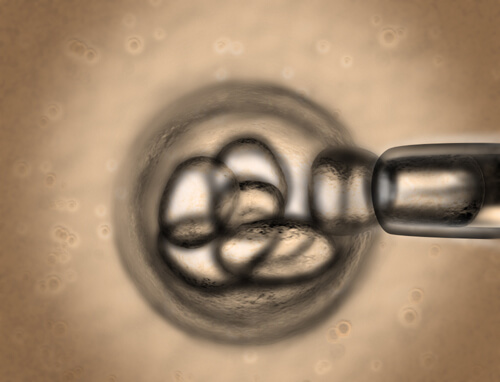

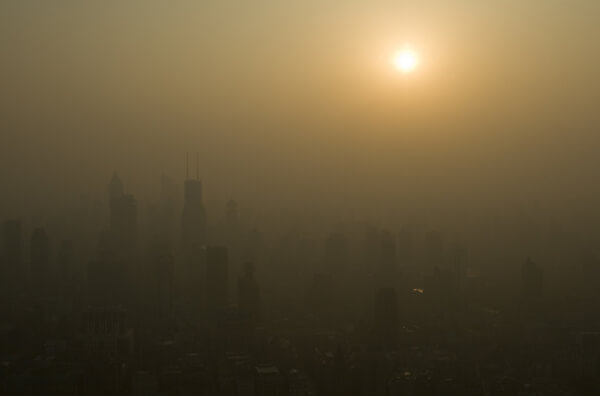
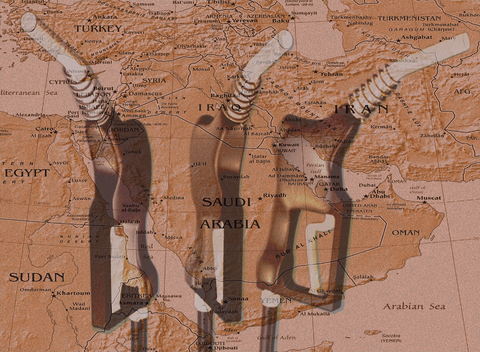
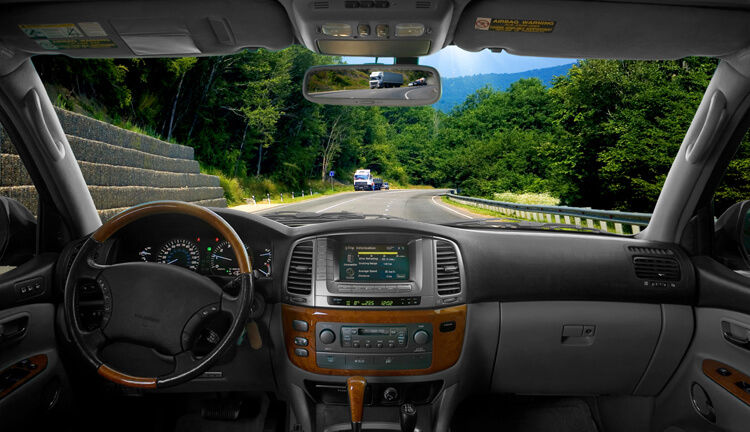


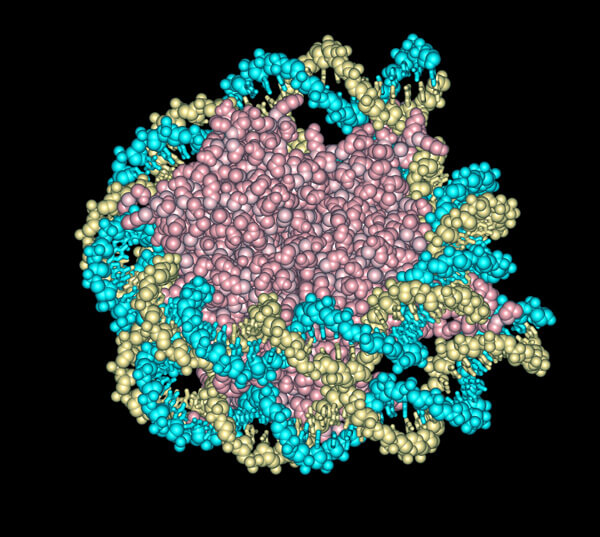
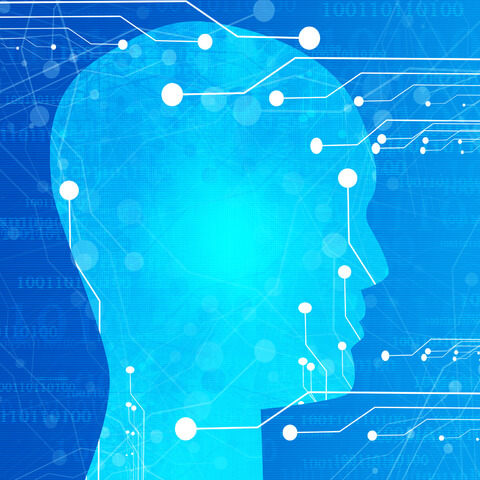



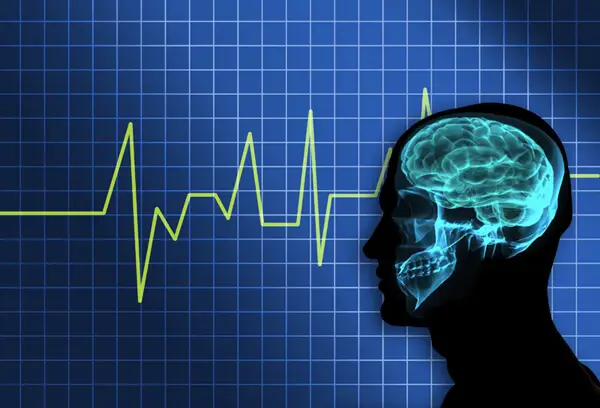
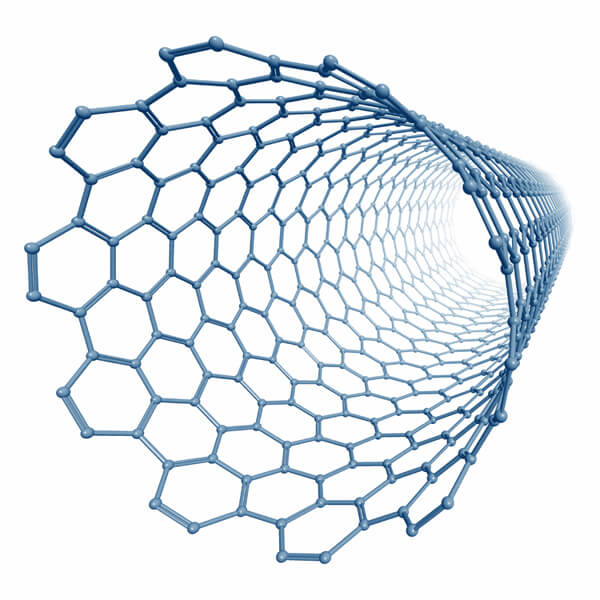
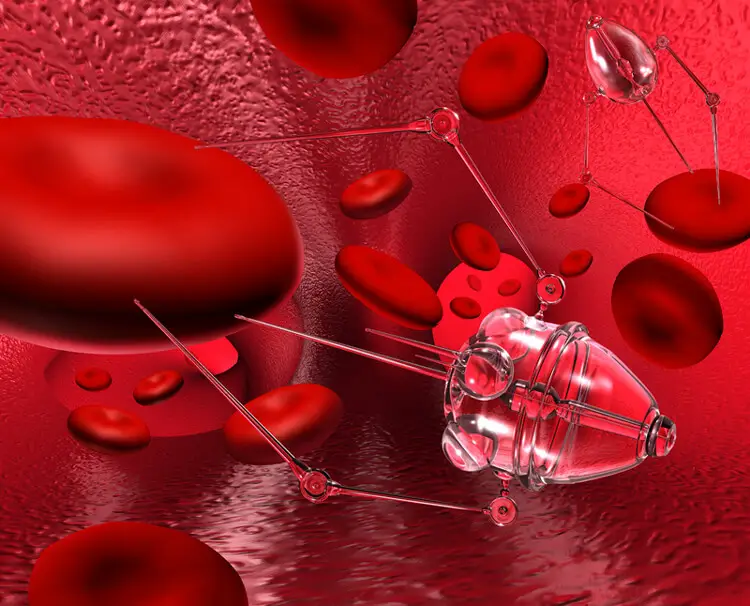
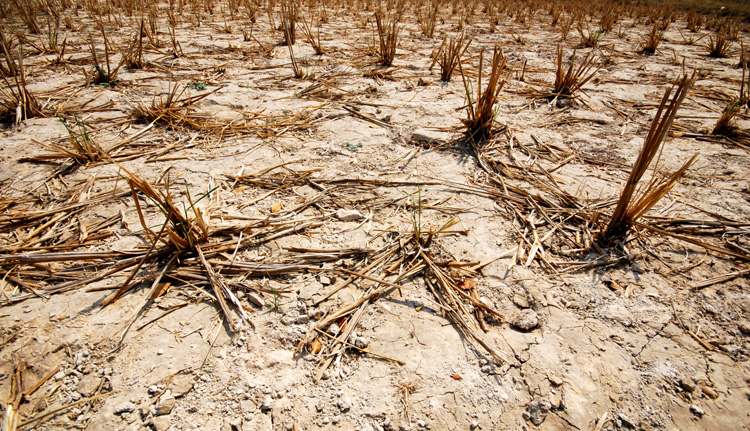

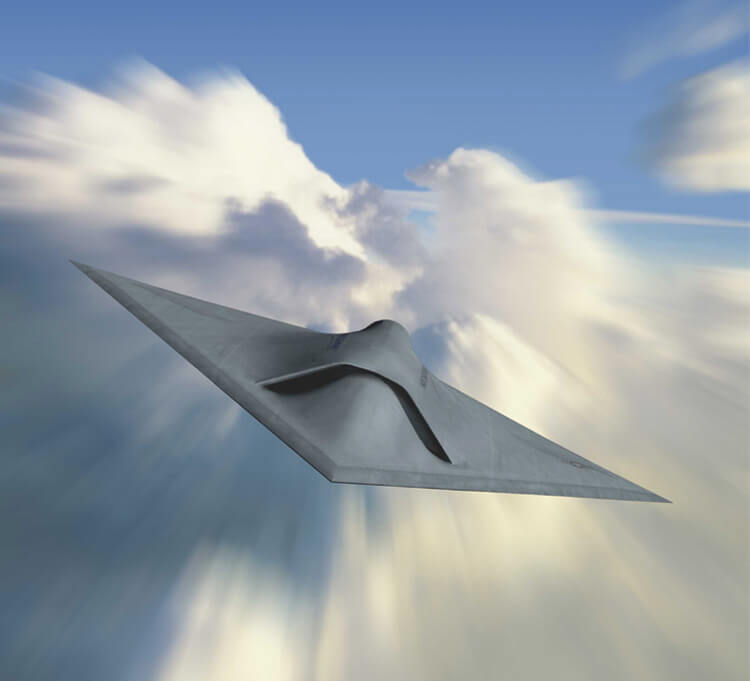
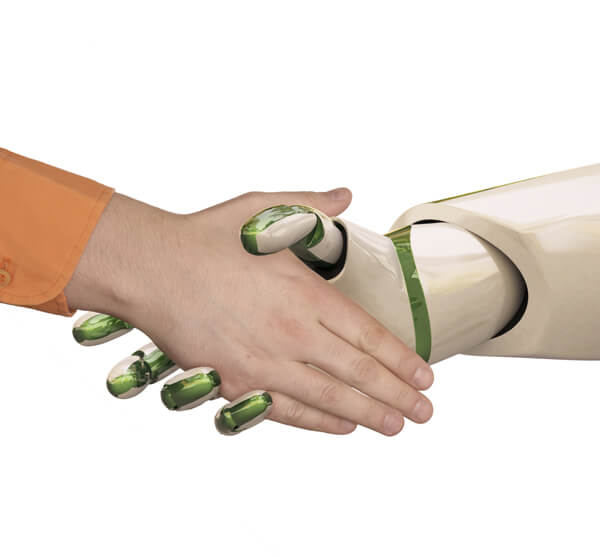

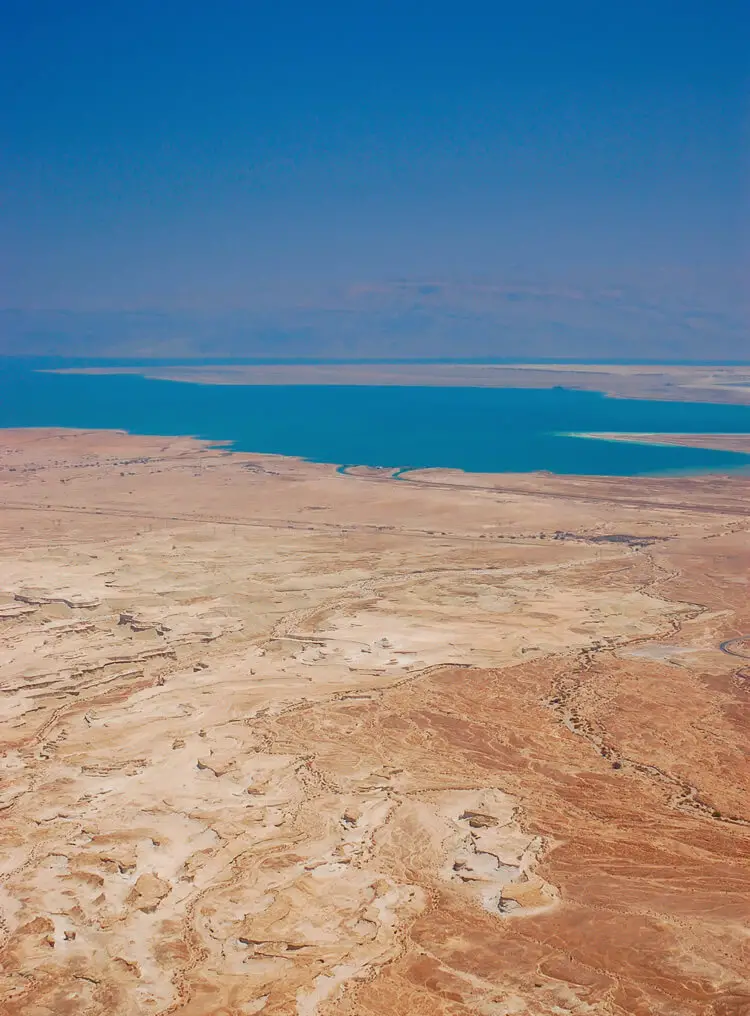
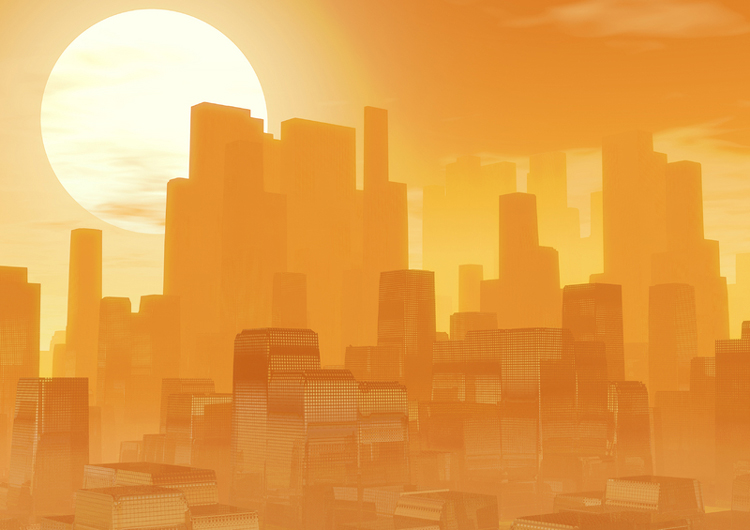



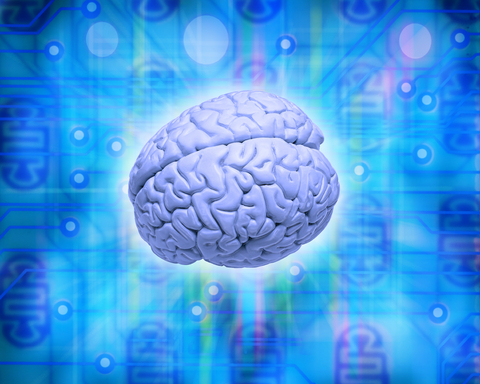
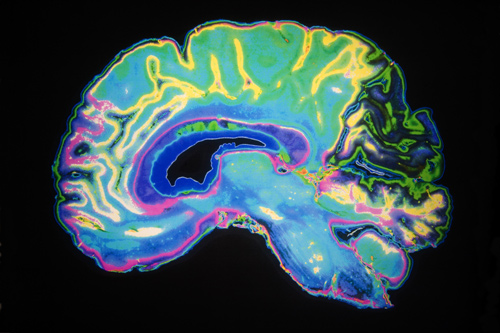


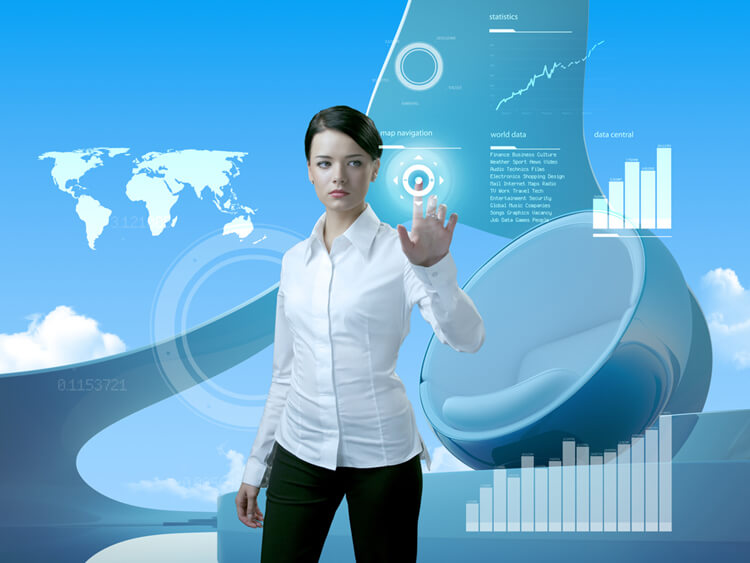

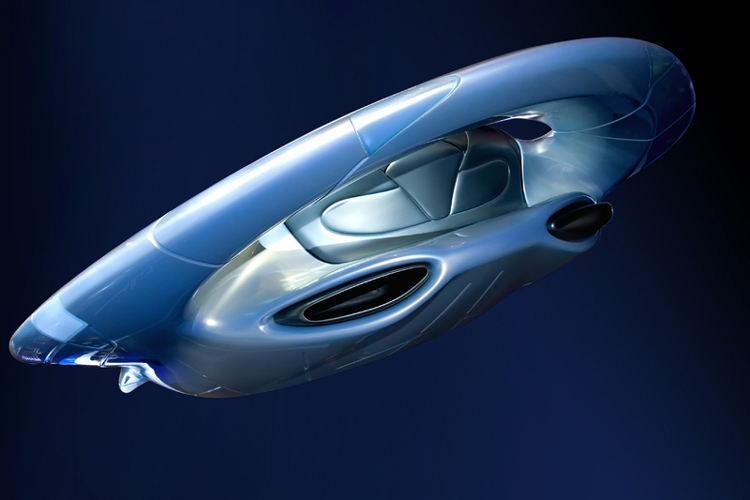


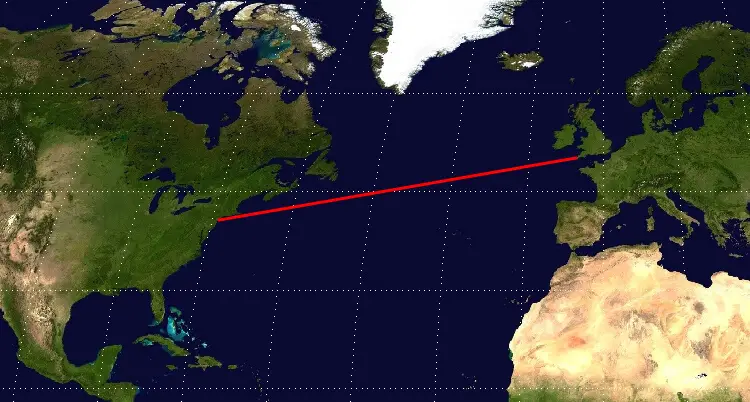
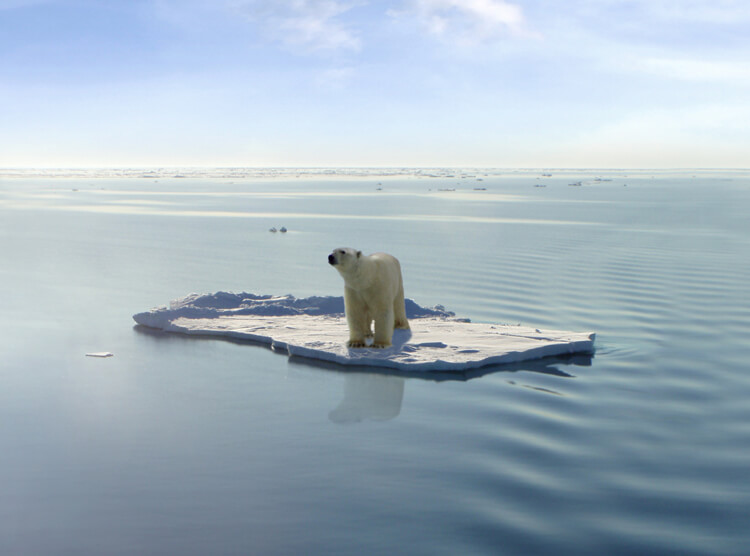
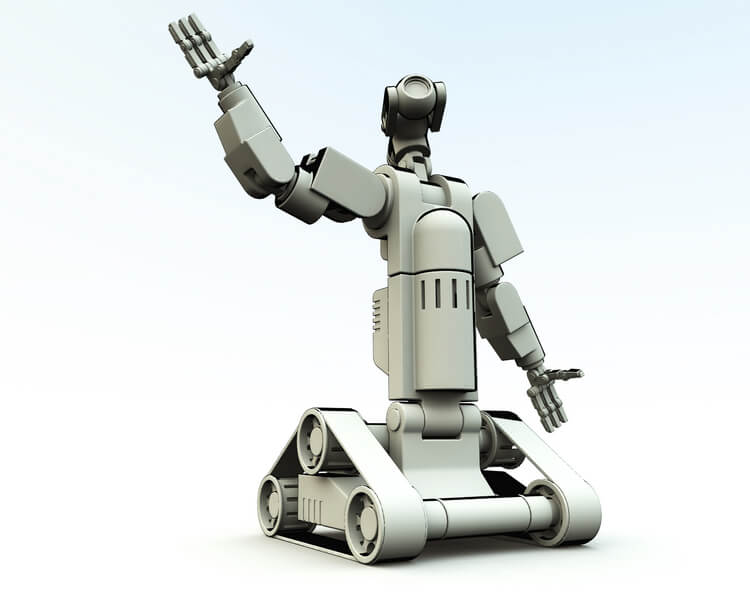
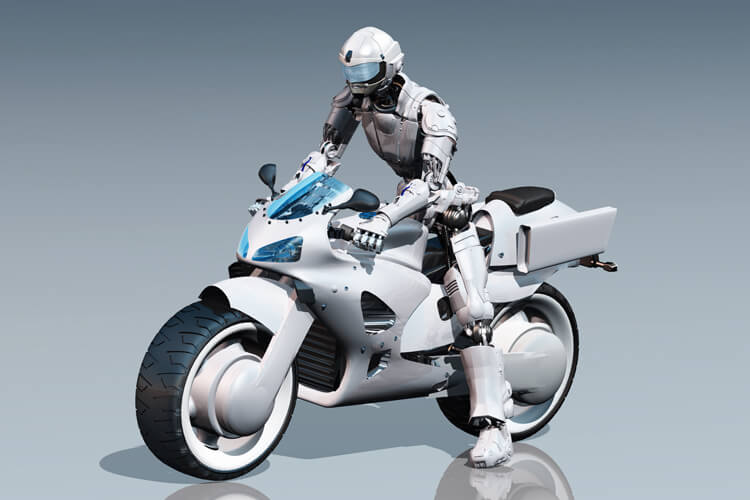
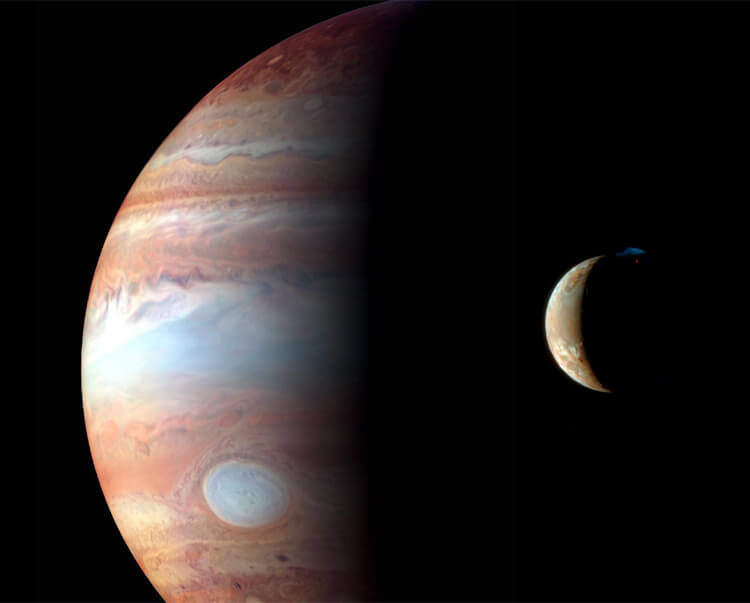

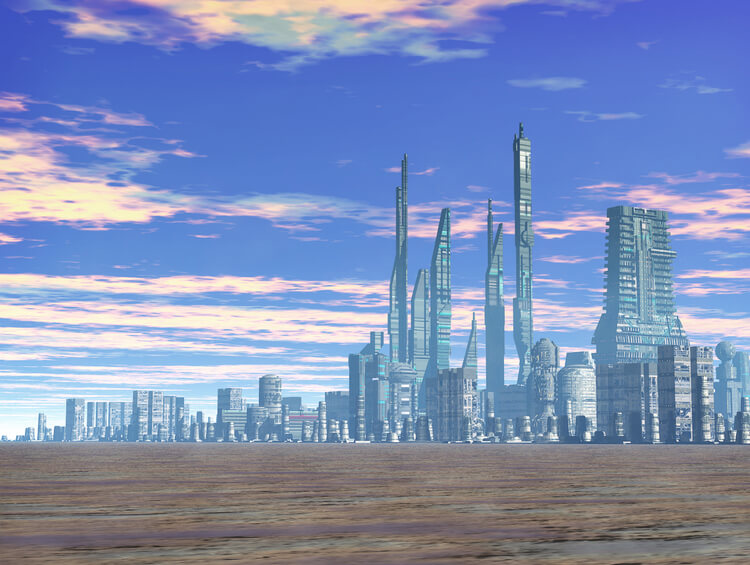

RăspundețiȘtergereFriday, September 04, 2015,
Dear Sirs,
I propose the scheme “Anatoliy Aleksenko’s Mechanism of renewal of energy” the AUTONOMOUS engine of the FUTURE which is able to create the efficiency of more than 1(ONE) and to have almost perpetual motor life.
It doesn’t need COOLING SYSTEM, it doesn’t use the FUEL but some lubricant, it doesn’t need any FILTERS and it is able to work “openly” underground, underwater, in GASEOUS ATMOSPHERE and in the OPEN SPASE. It is reversible, can work without transmission.
It’s a COLD MECHANISM which doesn’t need heating and then COOLING. Neither heat of deserts nor the Antarctic cold can hinder it’s work.
It’s production is not expensive, it is simple in operation. Any transportation (AUTO, AIR, SHIP’S, RAILWAY and other) will become profitable with this mechanism. It can not only compete with electric stations, atomic included but to give them odds. Neither the earthquakes nor other natural calamities frighten it. This is IDEAL for (ELECTRO-GENERATOR, BUS, TRUCK, SUV & VAN, HELICOPTER, DIRIGIBLE, EKRANOPLAN, UNMANNED AERIAL VEHICLE, JET PACK, HOVERCRAFT, AMPHIBIAN, SUBMARINE, REFRIGERATOR, RAILWAY, METRO, RAILGUN, LASER, OPEN SPACE…).
It can save the WORLD CIVILIZATION from the GLOBAL increasing of the temperature (HOTBED EFFECT, FLOODS, WATERSPOUTS…); oil pollution; energetic crisis; industrial breakdown; toxic gas ejection (CO, NO, CH); further destroying of the Ozone laver of the Earth; progressing AIDS (during the temperature increasing and organism dehydrating).
In case you are interested in this INFORMATION and you are going to become the Co-participant of the PROJECT, you are WELCOME to SEND SUGGESTIONS in RUSSIAN LANGUAGE to the address:
Anatoliy I. Aleksenko
Prospekt Octyabrskoy Revolyutsiyi, 57, apartment 87, 299057, Sevastopol – 57, ARC, Russia.
Telephone: +7 8692 433-365 ; Mobile: +7 978 0199 433
E-Mail: ecoglobal.aleksenko@yandex.ru
Skype: anatoliy.aleksenko
Having rendered the assistance in patenting and implementation, having become the Co-participant of the PROJECT, you will get rid of not only oil-gas and economic but also political DEPENDENCE.
Can you please pass this REPORT to all INTERESTED CIRCLES…
Please don’t forget of time factor.
Sincerely,
Anatoliy Aleksenko
INVENTOR